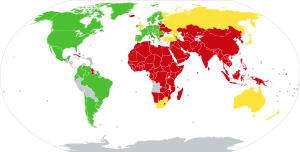Pornography

Pornography (colloquially known as porn or porno) has been defined as sexual subject material "such as a picture, video, or text" that is intended for sexual arousal.[a] Intended for consumption by adults, pornography depictions have evolved from cave paintings, some forty millennia ago, to virtual reality presentations. A general distinction of adult content is made classifying it as pornography or erotica.
The oldest artifacts considered pornographic were discovered in Germany in 2008 CE and are dated to be at least 35,000 years old.[b] Throughout the history of erotic depictions various people made attempts to suppress them under obscenity laws, censor, or make them illegal. Such grounds and even the definition of pornography have differed in various historical, cultural, and national contexts. The Indian Sanskrit text Kama Sutra (3rd century CE) contained prose, poetry, and illustrations regarding sexual behavior, and the book was celebrated; while the British English text Fanny Hill (1748), considered "the first original English prose pornography," has been one of the most prosecuted and banned books. In the late 19th century, a film by Thomas Edison that depicted a kiss was denounced as obscene in the United States, whereas Eugène Pirou's 1896 film Bedtime for the Bride was received very favorably in France. Starting from the mid-twentieth century on, societal attitudes towards sexuality became more lenient in the Western world where legal definitions of obscenity were made limited. In 1969, Blue Movie became the first film to depict unsimulated sex that received a wide theatrical release in the United States. This was followed by the "Golden Age of Porn" (1969–1984). The introduction of home video and the World Wide Web in the late 20th century led to global growth in the pornography business. Beginning in the 21st century, greater access to the Internet and affordable smartphones made pornography more mainstream.
Pornography has been vouched to provision a safe outlet for sexual desires that may not be satisfied within relationships and be a facilitator of sexual release in people who do not have a partner. It has been equated with journalism, as both offer a view into the unknown or the hidden aspects. Pornography use is considered a widespread recreational activity in-line with other digitally mediated activities such as use of social media or video games.[c] Motivations for pornography use may include fantasy, habitual use, mood management, or as part of a relationship. People who regard porn as sex education material were identified as more likely not to use condoms in their own sex life, thereby assuming a higher risk of contracting sexually transmitted infections (STIs); performers working for pornographic studios undergo regular testing for STIs unlike much of the general public. Comparative studies indicate higher tolerance and consumption of pornography among people tends to be associated with their greater support for gender equality, whereas another review which compiled evidence from other empirical sources such as surveys found that representations of women in pornography may lead adolescent boys to view women as sexual objects, with disregard and disrespect for gender equality. Among feminist groups, some seek to abolish pornography believing it to be harmful, while others oppose censorship efforts insisting it is benign. A longitudinal study had ascertained that pornography use is not a predictive factor in intimate partner violence.[d] Porn Studies, which began in 2014, is the first international peer-reviewed, academic journal dedicated to critical study of "products and services" deemed pornographic.
Pornographic websites rank among the top 50 most visited websites worldwide. Called an "erotic engine", pornography has been noted for its key role in the development of various communication and media processing technologies. For being an early adopter of innovations and as a provider of financial capital, the pornography industry has been cited to be a contributing factor in the adoption and popularization of media related technologies. The accurate economic size of the porn industry in the early twenty-first century is unknown. In 2015, estimates of the worldwide market value stood at US$97 billion, with the US revenue valued at $10 to $12 billion. The US revenue was estimated to have reached at least US$3.3 billion in 2020. Pornography in Japan was estimated to be worth over $20 billion in 2018. The US pornography industry employs numerous performers along with production and support staff, and has its own industry-specific publications: XBIZ and AVN; a trade association, the Free Speech Coalition; a labour union, Adult Performer Advocacy Committee; and award shows, XBIZ Awards and AVN Awards. From the mid 2010s, unscrupulous pornography such as deepfake pornography and revenge porn have become issues of concern.
Etymology and definition
The word pornography is a conglomerate of two ancient Greek words: πόρνος (pórnos) "fornicators", and γράφειν (gráphein) "writing, recording, or description".[1] In Greek language, the term pornography connotes depiction of sexual activity;[2] no date is known for the first use of the term pornography, the earliest attested, most related word found is πορνογράφος (pornographos) i.e. "someone writing about harlots" in the 3rd century CE work Deipnosophists by Athenaeus.[3][4]
The oldest published reference to the word pornography as in 'new pornographie,' is dated back to 1638 and is credited to Nathaniel Butter in a history of the Fleet newspaper industry.[5] The modern word pornography entered the English language as the more familiar word in 1842 via French "pornographie," from Greek "pornographos".[6]
The term porn is an abbreviation of pornography.[2] The related term πόρνη (pórnē) "prostitute" in Greek, originally meant "bought, purchased" similar to pernanai "to sell", from the proto-Indo-European root per-, "to hand over" — alluding to act of selling.[2]
The word pornography was originally used by classical scholars as "a bookish, and therefore inoffensive term for writing about prostitutes",[7] but its meaning was quickly expanded to include all forms of "objectionable or obscene material in art and literature".[7] In 1864, Webster's Dictionary published "a licentious painting" as the meaning for pornography,[7] and the Oxford English Dictionary: "obscene painting" (1842), "description of obscene matters, obscene publication" (1977 or earlier).[8]
Definitions for the term "pornography" are varied, with people from both pro- and anti-pornography groups defining it either favorably or unfavourably, thus making any definition very stipulative.[9][10][11] Nevertheless, academic researchers have defined pornography as sexual subject material "such as a picture, video, or text" that is primarily intended to assist sexual arousal in the consumer, and is created and commercialized with "the consent of all persons involved".[a] Arousal is considered the primary objective, the raison d'etre a material must fulfill for it to be treated as pornographic.[14] As some people can feel aroused by an image that is not meant for sexual arousal and conversely cannot feel aroused by material that is clearly intended for arousal, the material that can be considered as pornography becomes subjective.[14]
Pornography throughout history
Pornography from ancient times
As the very definition of pornography is subjective, a specified history of pornography is inconceivable.[15] Pornography is viewed by historians as a complex cultural formation.[16] Depictions of a sexual nature existed since prehistoric times as seen in Venus figurines and rock art.[17] People across various civilizations have created works that depicted explicit sex; these include artifacts, music, poetry, and murals among other things that are often intertwined with religious and supernatural themes.[18] The oldest artifacts, including the Venus of Hohle Fels, which are considered to be pornographic were discovered in 2008 CE at a cave near Stuttgart in Germany, radiocarbon dating suggests they are at least 35,000 years old, belonging to the Aurignacian period.[b]

Vast number of artifacts that have been discovered in ancient Mesopotamia had explicit depictions of heterosexual sex.[20][21] Glyptic art from the Sumerian Early Dynastic Period frequently shows scenes of frontal sex in the missionary position.[20] In Mesopotamian votive plaques, from the early second millennium BCE, a man is usually shown penetrating a woman from behind while she bends over drinking beer through a straw.[20] Middle Assyrian lead votive figurines often represented a man standing and penetrating a woman as she rests on an altar.[20]
Scholars have traditionally interpreted all these depictions as scenes of hieros gamos (an ancient sacred marriage between a god and a goddess), but they are more likely to be associated with the cult of Inanna, the Mesopotamian goddess of sex and sacred prostitution.[20] Many sexually explicit images, including models of male and female sexual organs, were found in the temple of Inanna at Assur.[20]
Depictions of sexual intercourse were not part of the general repertory of ancient Egyptian formal art, but rudimentary sketches of heterosexual intercourse have been found on pottery fragments and in graffiti.[22] The final two thirds of the Turin Erotic Papyrus (Papyrus 55001), an Egyptian papyrus scroll discovered at Deir el-Medina,[22] consists of a series of twelve vignettes showing men and women in various sexual positions. The scroll was probably painted in the Ramesside period (1292–1075 BCE) and its high artistic quality indicates that it was produced for a wealthy audience. No other similar scrolls have yet been discovered.[22]
Archaeologist Nikolaos Stampolidis had noted that the society of ancient Greece held lenient attitudes towards sexual representation in the fields of art and literature.[23] The Greek poet Sappho's Ode to Aphrodite (600 BCE) is considered an earliest example of lesbian poetry.[18] Red-figure pottery invented in Greece (530 BCE) often portrayed images that displayed eroticism.[24] The fifth-century BC comic Aristophanes elaborated 106 ways of describing the male genitalia and in 91 ways the female genitalia.[23] Lysistrata (411 BCE) is a sex-war comedy play performed in ancient Greece.[25]
In India, Hinduism embraced an inquisitive attitude towards sex as an art and a spiritual ideal.[26] Some ancient Hindu temples incorporated various aspects of sexuality into their art work. The temples at Khajuraho and Konark are particularly renowned for their sculptures, which had detailed representations of human sexual activity.[27] These depictions were viewed with a spiritual outlook as sexual arousal is believed to denote the embodying of the divine.[e]

"pornography is sometimes characterised as the symptom of a degenerate society, but anyone even noddingly familiar with Greek vases or statues on ancient Hindu temples will know that so-called unnatural sex acts, orgies and all manner of complex liaisons have for millennia past been represented in art for the pleasure and inspiration of the viewer everywhere. The desire to ponder images of love-making is clearly innate in the human – perhaps particularly the male – psyche." — Tom Hodgkinson[32]
Kama, the word used to connote sexual desire, was explored in Indian literary works such as the Kama Sutra, which dealt with the practical as well as the psychological aspects of human courtship and sexual intercourse.[33][34] The Sanskrit text Kama sutra was compiled by the sage Vatsyayana into its final form sometime during the second half of the third century CE.[35] This text, which included prose, poetry, as well as illustrations regarding erotic love and sexual behaviour,[18] is one of the most celebrated Indian erotic works.[36]
Koka shastra is another medieval Indian work that explored kama.[27] Other examples of early art and literature of sexual nature include: Ars Amatoria (Art of Love), a second-century CE treatise on the art of seduction and sensuality by the Roman poet Ovid;[15] the artifacts of the Moche people in Peru (100 CE to 800 CE);[18] The Decameron, a collection of short stories, some of which are sexual in nature by the 14th-century Italian author Giovanni Boccaccio;[15] and the fifteenth-century Arabic sex manual The Perfumed Garden.[18]
Pornography from early modern era
A highly developed culture of visual erotica flourished in Japan during the early modern era. From at least the 17th century, erotic artworks became part of the mainstream social culture.[15] Depictions of sexual intercourse were often presented on pictures that were meant to provide sex education for medical professionals, courtesans, and married couples. Makura-e (pillow pictures) were made for entertainment as well as for the guidance of married couples.[15] The ninth-century Japanese art form "Shunga" that depicted sexual acts on woodblock prints and paintings became so popular by the 18th century that the Japanese government began to issue official edicts against them. Even so, Japanese erotica flourished with the works of artists such as Suzuki Harunobu achieving worldwide fame.[18][15] Japanese censorship laws enacted in 1870 made the production of erotic works difficult. The laws remained in effect until the end of the Pacific War in 1945; nevertheless, pornography flourished through the sale of "erotic, grotesque, nonsense" (ero-guro-nansensu) periodicals, particularly in the Taishō era (1912-1926).[37] From the 1960s Pink films, which portrayed sexual themes became popular in Japan. In 1981 the first Japanese Adult video (AV) was released.[38] The Japanese pornography industry peaked in the early 2000s when about 30,000 AVs were made a year. From the mid 2010s increased availability of free porn on the Internet led to a decline in the production of AVs.[38] Other forms of adult entertainment such as Hentai, which refers to pornographic manga and anime, and erotic video games have become popular in recent decades.[38]

In Europe, the Italian Renaissance work from the 16th century - I Modi (The Ways) also known as The Sixteen Pleasures became famous for its engravings that explicitly depicted sex positions.[39] The publication of this book was considered the beginning of print pornography in Rome.[40] The second edition of this book was published in 1527, titled Aretino Postures, which combined erotic images with text - a first in the Western culture.[40] The Vatican called for the complete destruction of all the copies of the book and imprisonment of its author Marcantonio Raimondi.[40] With the development of printing press in Europe, the publication of written and visual material, which was essentially pornographic began. Heptaméron written in French by Marguerite de Navarre and published posthumously in 1558 is one of the earliest examples of salacious texts from this era.[15] Beginning with the Age of Enlightenment and advances in printing technology, the production of erotic material became popular enough that an underground marketplace for such works developed in England with a separate publishing and bookselling business.[15] Historians have identified the 18th century as an age of pornographic opulence.[41] Written by anonymous authors, the titles: The Progress of Nature (1744); The History of the Human Heart: or, the Adventures of a Young Gentleman (1749), which had descriptions of female ejaculation; and The Child of Nature (1774) have been noted as prominent pornographic fictional works from this period.[42] The book Fanny Hill (1748), is considered "the first original English prose pornography, and the first pornography to use the form of the novel."[43] An erotic literary work by John Cleland, Fanny Hill was first published in England as Memoirs of a Woman of Pleasure.[44][45] The novel has been one of the most prosecuted and banned books in history.[46][47] The author John Cleland was charged for "corrupting the King's subjects."[48]

At around the same time, erotic graphic art that began to be extensively produced in Paris came to be known in the Anglosphere as "French postcards".[15] Enlightenment-era France had been noted by historians as the centre of origin for modern-era pornography.[49] The works of French pornography, which often concentrated on the education of an ingénue into libertine, dominated the sale of sexually explicit content.[50] The French sought to interlace narratives of sexual pleasure with philosophical and anti-establishment basis.[50] Political pornography began with the French Revolution (1789–99).[51] Apart from the sexual component, pornography became a popular medium for protest against the social and political norms of the time.[15] Pornography during this period was used to explore the ideas of sexual freedom for women and men, the various methods of contraception, and to expose the offences of powerful royals and elites.[15] The working and lower classes in France produced pornographic material en masse with themes of impotency, incest, and orgies that ridiculed the authority of the Church-State, aristocrats, priests, monks, and other royalty.[51] One of the most important authors of socially radical pornography was the French aristocrat Marquis de Sade (1740–1814), whose name helped derive the words "sadism" and "sadist". He advocated libertine sexuality and published writings that were critical of authorities, many of which contained pornographic content.[52] His work Justine (1791) interlaced orgiastic scenes along with extensive debates on the ills of property and traditional hierarchy in society.[15]

When large-scale archaeological excavations were undertaken in the ancient Roman city of Pompeii during the 18th century, much of the erotic art in Pompeii and Herculaneum came to light, shocking the authorities who endeavored to hide them away from the general public. In 1821 the moveable objects were locked away in the Secret Museum in Naples, and what could not be removed was either covered or cordoned off from public view.[53]
During the Victorian era (1837–1901) the invention of the rotary printing press made publication of books easier, many works of lascivious nature were published during this period often under pen names or anonymity.[55] In 1837 the Holywell Street (known as "Booksellers' Row") in London had more than 50 shops that sold pornographic material.[15] Many of the works published in the Victorian era are considered bold and graphic even by today's lenient standards.[56] The english novel The Adventures, Intrigues, and Amours, of a Lady's Maid! written by anonymous "Herself" (c. 1838) professed the notion that homosexual acts are more pleasurable for women than heterosexuality which is linked to painful and uncomfortable experiences.[57] Some of the popular publications from this era include: The Pearl (magazine of erotic tales and poems published from 1879 to 1881); Gamiani, or Two Nights of Excess (1870) by Alfred de Musset; and Venus in Furs (1870) by Leopold von Sacher-Masoch, from whose name the term "masochism" was derived.[55] The Sins of the Cities of the Plain (1881) is one of the first sole male homosexual literary work published in English, this work is said to have inspired another gay literary work Teleny, or The Reverse of the Medal (1893), whose authorship has often been attributed to Oscar Wilde.[56] The Romance of Lust, written anonymously and published in four volumes during 1873–1876, contained graphical descriptions of themes detailing incest, homosexuality, and orgies.[58] Other publications from the Victorian era that included fetish and taboo themes such as sadomasochism and 'cross-generational sex' are: My Secret Life (1888–1894) and Forbidden Fruit (1898). On accusations of obscenity many of these works had been outlawed until the 1960s.[58]
Criminalization
The English act
The world's first law that criminalized pornography was the English Obscene Publications Act 1857, enacted at the urging of the Society for the Suppression of Vice.[59][58] The act passed by the British Parliament in 1857 applied to the United Kingdom and Ireland. The act made the sale of obscene material a statutory offence, and gave the authorities the power to seize and destroy any material which they considered as obscene.[60][61]
For centuries before, sexually explicit material was considered a domain that is exclusive to aristocratic classes.[40] When pornographic material flourished in the Victorian-era England, the affluent classes believed they are sensible enough to deal with it, unlike the lower working classes whom they thought would get distracted by such material and cease to be productive. Beliefs that masturbation would make people ill, insane, or become blind also flourished.[58] The obscenity act gave government officials the power to interfere in the private lives of people unlike any other law before.[60] Some of the people suspected for masturbation were forced to wear chastity devices. "Cures" and "treatment" for masturbation involved such measures like giving electric shock and applying carbolic acid to the clitoris.[58] The law was criticised for being established on still yet unproven claims that sexual material is noxius for people or public health.[60]
The American act
In 1865, the US postal service was seen as a "vehicle" for the transmission of materials that were deemed obscene by the American lawmakers.[62] An act relating to the postal services was passed, which made people pay a fine of $500 for knowingly mailing any "obscene book, pamphlet, picture print, or other publication".[63] From 1865 to up until the first three months of 1872, a total number of nine people were held for various charges of obscenity, with one person sentenced to prison for a year; while in the next ten months fifteen people were arrested under this law. This was partly due to the efforts of Anthony Comstock, who became a major figure in 1872 and held great power to control sexual related activities of people including the choice of abortion.[64] The Comstock Act of 1873 is the American equivalent of the English Obscene Act.[65][66] The anti-obscenity bill, drafted by Anthony Comstock, was debated for less than an hour in the US Congress before being passed into law.[67] Apart from the power to seize and destroy any material alleged to be obscene, the law made it possible for the authorities to make arrests over any perceived act of obscenity, which included possession of contraceptives by married couples. Reportedly in the US, 15 tonnes of books and 4 million pictures were destroyed, and about 15 people were driven to suicide with 4,000 arrests.[67] At least 55 people whom Comstock identified as abortionists got indicted under the Comstock act.[68]
Steps towards liberalization
The laws regarding pornography have differed in various historical, cultural, and national contexts.[69] The English Act did not apply to Scotland where the common law continued to apply. Before the English Act, publication of obscene material was treated as a common law misdemeanour,[70] this made effectively prosecuting authors and publishers difficult even in cases where the material was clearly intended as pornography.[71] However, neither the English, nor the United States Act defined what constituted "obscene", leaving this for the courts to determine.[70] For implementing the Comstock act, the US courts used the British Hicklin test to define obscenity, the definition of which was first proposed in 1868, ten years after the passing of the English obscene act.[61] The definition became cemented in 1896 and continued until the mid-twentieth century. Starting from 1957 to 1997, the US Supreme Court made numerous judgements that redefined Obscenity.[67][72]
The nineteenth-century legislation eventually outlawed the publication, retail and trafficking of certain writings and images that were deemed pornographic. Although laws ordered the destruction of shop and warehouse stock meant for sale, the private possession and viewing of (some forms of) pornography was not made an offence until the twentieth century.[71] Historians have explored the role of pornography in determining social norms.[73] The Victorian attitude that pornography was only for a select few is seen in the wording of the Hicklin test, stemming from a court case in 1868, where it asked: "whether the tendency of the matter charged as obscenity is to deprave and corrupt those whose minds are open to such immoral influences".[74]
Although officially prohibited, the sale of sexual material nevertheless continued through "under the counter" means. Magazines specialising in a genre called "saucy and spicy" became popular during this time (1896 to 1955), titles of few popular magazines include; Wink: A Whirl of Girls, Flirt: A FRESH Magazine, and Snappy. Cover stories in these magazines featured segments such as "perky pin-ups" and "high-heel cuties".[75] Some of the popular erotic literary works from the twentieth century include the novels: Story of the Eye (1928), Tropic of Cancer (1934), Tropic of Capricorn (1938), the French Histoire d'O (Story of O) (1954); and the short stories: Delta of Venus (1977), and Little Birds (1979).[76]
After the invention of photography, the birth of erotic photography followed. The oldest surviving image of a pornographic photo is dated back to about 1846, described as to depict "a rather solemn man gingerly inserting his penis into the vagina of an equally solemn and middle-aged woman".[75] At one point of time, it was more expensive to purchase an erotic photograph than to hire a prostitute.[77] The Parisian demimonde included Napoleon III's minister, Charles de Morny, an early patron who delighted in acquiring and displaying erotic photos at large gatherings.[78]
Pornographic film production commenced almost immediately after the invention of the motion picture in 1895. A pioneer of the motion picture camera, Thomas Edison, released various films, including The Kiss that were denounced as obscene in late 19th century America.[79][80] Two of the earliest pioneers of pornographic films were Eugène Pirou and Albert Kirchner. Kirchner directed the earliest surviving pornographic film for Pirou under the trade name "Léar". The 1896 film, Le Coucher de la Mariée, showed Louise Willy performing a striptease. Pirou's film inspired a genre of risqué French films that showed women disrobing, and other filmmakers realised profits could be made from such films.[81][82]
Legalization
Sexually explicit films opened producers and distributors to be liable for prosecution. Such films were produced illicitly by amateurs, starting in the 1920s, primarily in France and the United States. Processing the film was risky as was their distribution, which was strictly private.[83] In the western world, during the 1960s, social attitudes towards sex and pornography slowly changed.[84] In 1967 Denmark repealed the obscenity laws on literature, this led to a decline in the sale of pornographic and erotic literature. Hoping for a similar effect, in the summer of 1969, legislators in Denmark abolished censorship on picture pornography,[85] thereby effectively becoming, from July 1, 1969, the first country that legalized pornography,[86][87] including child pornography, which was later prohibited in 1980.[88][89] The 1969 legislation, instead of resulting in a decline in pornography production, led to an explosion of investment in, and commercial production of pornography in Denmark, which made the country's name synonymous with sex and pornography.[85] The total retail turnover of pornography in Denmark for the year 1969 was estimated at $50 million. Much of the pornographic material produced in Denmark was smuggled into other countries around the world.[90]

In the United States, pornography is protected by the First Amendment to the United States Constitution unless it constitutes obscenity or child pornography that is produced with real children. Nevertheless, in Stanley v. Georgia (1969), the U.S. Supreme Court upheld the right of an adult to possess obscene material in private.[91] Subsequently, however, the Supreme Court rejected the claim that under Stanley there is a constitutional right to provide obscene material for private use[92] or to acquire it for private use.[93] The right to possess obscene material does not imply the right to provide or acquire it, because the right to possess it "reflects no more than ... the law's 'solicitude to protect the privacies of the life within [the home]'".[94]
In 1969, Blue Movie by Andy Warhol became the first feature film to depict explicit sexual intercourse that received a wide public theatrical release in the United States.[95][96]
Blue Movie was real. But it wasn't done as pornography—it was done as an exercise, an experiment. But I really do think movies should arouse you, should get you excited about people, should be prurient. Prurience is part of the machine. It keeps you happy. It keeps you running."
Film scholar Linda Williams remarked that prurience "is a key term in any discussion of moving-image sex since the sixties. Often it is the "interest" to which no one wants to own up".[98] In 1968, the Motion Picture Association of America created a new film ratings system in which any film that wasn't approved by the association was released with an "X" rating. When pornographers began to release their productions with the rating X, the association adopted NC-17 rating for adults only films, leaving the X rating to pornography. Later the invented gimmick rating "XXX" became a standard for pornographic material.[99]
Commissions and their findings
In 1970, the United States President's Commission on Obscenity and Pornography, set up to study the effects of pornography, reported that there was "no evidence to date that exposure to explicit sexual materials plays a significant role in the causation of delinquent or criminal behavior among youths or adults".[100] The report further recommended against placing any restriction on the access of pornography by adults and suggested that legislation "should not seek to interfere with the right of adults who wish to do so to read, obtain, or view explicit sexual materials".[101] Regarding the notion that sexually explicit content is improper, the Commission found it "inappropriate to adjust the level of adult communication to that considered suitable for children". The Supreme Court supported this view.[101]
In 1971, Sweden removed its obscenity clause. Further relaxation of legislations during the early 1970s in the US, West Germany and other countries led to rise in pornography production.[90] The 1970s had been described by Linda Williams as 'the "Classical" Era of Theatrically Exhibited Porn', a time period now called the Golden Age of Porn.[90][102]
In 1979, the British Committee on Obscenity and Film Censorship better known as the Williams Committee, formed to review the laws concerning obscenity reported that pornography could not be harmful and to think anything else is to see pornography "out of proportion". The committee declared that existing variety of laws in the field should be scrapped and so long as it is prohibited from children, adults should be free to consume pornography as they see fit.[103][104]
The Meese Report in 1986 argued against loosening restrictions on pornography in the US. The report was criticized as biased, inaccurate, and not credible.[105]
In 1988, the Supreme Court of California ruled in the People v. Freeman case that "filming sexual activity for sale" does not amount to procuring or prostitution and shall be given protection under the first amendment.[106] This ruling effectively legalized the production of X-rated adult content in the Los Angeles county, which by 2005 had emerged as the largest centre in the world for the production of pornographic films.[106][107] Pornographic films appeared throughout the twentieth century. First as stag films (1900–1940s), then as porn loops or short films for peep shows (1960s), followed by as feature films for theatrical release in adult movie theaters (1970s), and as home videos (1980s).[108]
Role of magazines in legalization
Pornographic magazines published during the mid-twentieth century have been noted for playing an important role in the sexual revolution[109] and the liberalization of laws and attitudes towards sexual representation in the Western world.[110] Hugh Hefner, in 1953 published the first US issue of the Playboy, a magazine which as Hefner described is a "handbook for the urban male". The magazine contained images of nude women along with articles and interviews covering politics and culture.[76] Twelve years later, in 1965 Bob Guccione in the UK started his publication Penthouse, and published its first American issue in 1969 as a direct competitor to Playboy. In its early days, the images of naked women published in Playboy did not show any pubic hair or genitals. Penthouse became the first magazine to show pubic hair in 1970. Playboy followed the lead and there ensued a competition between the two magazines over publication of more racy pictures, a contest that eventually got labelled as the "Pubic wars".[110]
"We were the first to show full frontal nudity. The first to expose the clitoris completely. I think we made a very serious contribution to the liberalization of laws and attitudes. HBO would not have gone as far as it does if it wasn't for us breaking the barriers. Much that has happened now in the Western world with respect to sexual advances is directly due to steps that we took." — Bob Guccione, Penthouse founder in 2004.[110]
The tussle between Playboy and Penthouse paled into obscurity when Larry Flynt started Hustler, which became the first magazine to publish labial "pink shots" in 1974. Hustler projected itself as the magazine for the working classes as opposed to the urban centered Playboy and Penthouse.[111] During the same time in 1972, Helen Gurley Brown, editor of the Cosmopolitan magazine, published a centerfold that featured actor Burt Reynolds in nude. His popular pose has been later emulated by many other famous people. The success of Cosmo led to the launch of Playgirl in 1973.[111] At their peak, Playboy sold close to six million copies a month in the US, while Penthouse nearly five million. In the 2010s, as the market for printed versions of pornographic magazines declined, with Playboy selling about a million and Penthouse about a hundred thousand, many magazines became online publications.[112] The best-selling US adult magazines maintain greater reach compared to most other non-pornographic magazines, and often rank among top-sellers.[113]
Modern-day pornography
Modern-day pornography began to take shape from the mid 1980s when the first desktop computers and public computer networks were released.[114] Since the 1990s, the Internet has made pornography more accessible and culturally visible.[115] Before the 90s, Usenet newsgroups served as the base for what has been called the "amateur revolution" where non-professionals from the late 1980s and early 1990s, with the help of digital cameras and the Internet, created and distributed their own pornographic content independent of mainstream networks.[116] The use of the World Wide Web became popular with the introduction of Netscape navigator in 1994. This development led to newer methods of pornography distribution and consumption.[117] The Internet turned out to be a popular source for pornography and was called the "Triple A-Engine" for offering consumers "anonymity, affordability, and accessibility", while driving the business of pornography.[114] The notion of Internet being a medium abound with porn became popular enough that in 1995 Time published a cover story titled "CYBERPORN" with the face of a shocked child as the cover photo.[118] In the Reno v. ACLU (1997) ruling, the US Supreme Court upheld the legality of pornography distribution and consumption by adults over the Internet. The Court noted that Government may not reduce the communication between adults to "only what is fit for children".[119][61]
With the introduction of broadband connections, much of the distribution networks of pornography moved online giving consumers anonymous access to a wide range of pornographic material.[115] To have better control over their content on the Internet some professional pornographers maintain their own websites.[114] Danni's Hard Drive started in 1995 by Danni Ashe is considered one of the earliest online pornographic websites, coded by Ashe – a former stripper and nude model, the website was reported by CNN to had generated revenues of $6.5 million by 2000.[120][117] According to some leading pornography providers on the Internet, customer subscription rates for a website would be about one in a thousand people who visit the site for a monthly fees averaging around $20.[121] Ashe said in an interview that her website employs 45 people and she expects to earn $8 million in 2001 alone.[122] The total number of pornographic websites in 2000 were estimated to be more than 60,000.[121] The development of streaming sites, peer-to-peer file sharing (P2P) networks, and tube sites led to a subsequent decline in the sale of DVDs and adult magazines.[115]
Starting in the 21st century, greater access to the Internet and affordable smartphones made pornography more accessible and culturally mainstream.[123][9] The total number of pornographic websites in 2012 was estimated to be around 25 million comprising 12% of all the websites.[120] About 75 percent of households in the US gained Internet access by 2012.[124] Data from 2015 suggests an increase in pornography consumption over the past few decades which is attributed to the growth of Internet pornography.[125] Technological advancements such as digital cameras, laptops, smartphones, and Wi-Fi have democratized the production and consumption of pornography.[116][126][127] Subscription-based service providers such as OnlyFans, founded in 2016, are becoming popular as the platforms for pornography trade in the digital era.[128][129] Apart from the professional pornographers, content creators on such platforms include others like;[128] a physics teacher,[130] a race car driver,[131] a woman undergoing cancer treatment.[132] In 2022, the total pornographic content accessible online was estimated to be over 10,000 terabytes.[133]
AVN and XBIZ are the industry-specific organizations based in the US that provide information about the adult entertainment business.[134] XBIZ Awards and AVN Awards, analogous to the Golden globes and Oscars, are the two prominent award shows of the adult entertainment industry.[135][136] Free Speech Coalition (FSC) is a trade association and Adult Performer Advocacy Committee (APAC) is a labour union for the adult entertainment industry based in the US.[137] The scholarly study of pornography notably in cultural studies is limited. Porn Studies, which began in 2014, is the first international peer-reviewed, academic journal that is exclusively dedicated to the critical study of the "products and services" identified to constitute pornography.[138]
Classification and commercialism
Adult content classifications
A distinction is often made regarding adult content classifying it as either pornography or erotica.[139] Considerations of distinctness between erotica and pornography is mostly subjective.[15] Pornographic content is generally classified as either softcore or hardcore.[114] Softcore pornography contains depictions of nudity but without explicit depiction of sexual activity.[114] Hardcore pornography contains explicit depiction of sexual activity.[140] Hardcore porn is more regulated than softcore porn.[140] Softcore porn was popular between the 1970s and 1990s.[141]
Mainstream pornography
Pornography productions cater to consumers of various sexual orientations.[142] Nonetheless, pornography featuring heterosexual acts made for heterosexual consumers, comprise the bulk of what is called the "mainstream porn", marking the industry more or less as "heteronormative".[142][143]
Mainstream pornography involves professional performers who work for various corporate film studios in their respective productions.[144]

Mainstream pornography productions are usually classified as feature or gonzo.[142][145] Features involve storylines, characterizations, scripted dialogue, elegant costumes, detailed sets, and soundtracks, which make the productions look similar to mainstream Hollywood productions but with the depictions of explicit sexual activity included.[142][145][146] Features contain both original narratives as well as parodies that parody mainstream feature films, TV shows, celebrities, video games or literary works.[147][148][149] Gonzo is a form of content creation that attempts to put the viewer into the scene, this is commonly achieved by close-up camera work or performers talking to the audience; also called "wall-to-wall", gonzo involves some aspects of "breaking the fourth wall" between the audience and performers.[145][147] The term "gonzo" is often misused as a genre to identify demeaning depictions, however gonzo is a film-making style and not a genre.[147] Gonzo style is variably incorporated in the creation of all types or genres of adult content.[147] Gonzos do not involve the expensive sets or the costly production values of features, which makes their production relatively inexpensive.[146][147] From the mid 2010s about 95 percent of porn productions are gonzo.[127]
Indie pornography
Pornography productions that are independent of mainstream pornographic studios are classified as indie (or) independent pornography.[150] These productions cater to more specific audience, and often feature different scenarios and sexual activity compared to the mainstream porn.[150][143] The performers in indie porn include real-life couples and regular people, who sometimes work in partnership with other performers. Apart from content creation the performers do the background work such as videography, editing, web development themselves, and distribute under their own brand.[150] Paysites like Clips4Sale.com, MakeLoveNotPorn.tv, and PinkLabel.tv provide a platform to the web-based content of independent pornographers.[147][151][152]
Genres
Pornography encompasses a wide variety of genres providing for an enormous range of consumer tastes.[143][153] Most of the genres or types are named according to the depiction of sexual activity, these include: anal, creampie, cum shot, double penetration, fisting, threesome.[153] Categorizations based on the age of the performers include: teens, milf, mature.[153] Other categorizations based on the gender and sexual identity include: lesbian, transsexual, queer, shemale; while those based on race include: ethnic, interracial.[153] Others include: mormon,[154] zombie.[155] Pornography also features numerous fetishes like: "'fat' porn, amateur porn, disabled porn, porn produced by women, queer porn, BDSM and body modification."[f]
Commercialism
Pornography is commercialized mainly through the sale of pornographic films. The release of VCR by Sony corporation for mass market in 1975 marked the shift of people from watching porn in adult movie theatres to the confines of their home.[121] The introduction of pay-per-view model enabled people to buy adult content directly from cable and satellite TV service providers. According to Showtime Television network report, in 1999 adult pay-per-view services made $367 million, which was six times more than the $54 million earned in 1993.[121] Retail stores or sex shops engaged in the sale of adult entertainment material, ranging from videos, magazines, to sex toys and other products, significantly contributed to the commercialization of pornography.[122][114] Sex shops sell their products on both online shopping platforms such as Amazon and on specialized websites.[114]
In 2000, the total annual revenue from the sales and rentals of pornographic material in the US was estimated to be over $4 billion,[121] the hotel industry through the sale of adult movies to their customers as part of room service, over pay-per-view channels, had generated an annual income of about $180-$190 million.[121] Some of the major companies and hotel chains that were involved in the sale of adult films over pay-per-view platforms include; AT&T, Time Warner, DirecTV from General Motors, EchoStar, Liberty Media, Marriott International, Westin and Hilton Worldwide. The companies said their services are in response to a growing American market that wanted pornography delivered at home.[121][122]
| Commercialization of pornography | |||
|
Economics
The production and distribution of pornography are economic activities of some importance. In the United States, the pornography industry employs about 20,000 people including 2000 to 3000 performers,[156] and is centered in the San Fernando Valley of Los Angeles. By 2005 it became the largest pornography production centre in the world.[106][107] Apart from regular media coverage, the industry in the US receives considerable attention from private organizations, government agencies, and political organizations.[157] In Europe, Budapest is regarded as the industry center.[158][159] Other pornography production centres in the world are located in Florida (US), Brazil, Czech Republic, and Japan.[107]

Revenues of the adult industry in the United States are difficult to determine. A 1970 federal study estimated that the total retail value of hardcore pornography in the United States was no more than $5 million to $10 million.[101][121] Many adult films had theatrical releases during the 1970s corresponding with the Golden Age of Porn. The introduction of VHS brought down the production quality through the 1980s.[102] By the mid 1990s the adult film industry had agents for performers, shooting permits, production teams, distributors, advertisers, industry magazines, and trade associations.[102] Performers used to get multi-film contracts.[127] In 1995, Jenna Jameson signed her first contract with the porn studio Wicked Pictures.[102] After building a brand image for herself she started her own company ClubJenna, which by 2005 was reportedly earning an annual revenue of $30-$35 million.[102][127]
Starting in the 1990s, Internet eased the access of pornography.[122] Although this development resulted in the decline of Video rentals, the revenues generated from pay-per-view models over the Internet provided much financial gains for pornography producers and credit card companies among others.[121] In 1998, Forrester Research published a report on the online "adult content" industry, estimating annual revenue at $750 million to $1 billion.[162] The introduction of home video and the World Wide Web in the late twentieth century led to a global growth in the pornography business.[163] Studies in 2001 had put the total US annual revenue (including video, pay-per-view, Internet and magazines) between $2.6 billion and $3.9 billion.[162]
As of 2011, pornography was becoming one of the biggest businesses in the United States.[164] In 2014, the porn industry was believed to bring in at least $13 billion on a yearly basis in the United States.[165] Through the 2010s, many pornography production companies and top pornographic websites such as Pornhub, RedTube and YouPorn have been acquired by MindGeek, a company that has been described as "a monopoly" in the pornography business.[166] This development was identified as a problem. According to Marina Adshade, a professor from the Vancouver School of Economics and the author of Dollars and Sex: How economics influences sex and love, having a monopoly in the pornography business has forced the producers to reduce their charges, and radically changed the work of performers "who are now under greater pressure to perform acts that they would have been able to refuse in the past", all at a lower price without profits for themselves.[77]
Online pornography is available both for a fee and free of charge.[114] The availability of free porn on the Internet has led to a decline in the business of mainstream pornography.[167][77] Piracy is estimated to result in losses of some $2 billion a year for the porn industry.[127] Budgets of many studios reduced considerably and contracts for performers became less common.[127] Reportedly, applications by established pornography companies for porn-shoot permits in Los Angeles County fell by 95 percent during the period 2012 to 2015.[167][102] According to Mark Spiegler, an adult talent agent, in the early 2000s female performers made about $100,000 a year. By 2017, the amount is about $50,000.[127]
The technological era led to decline of the studio and "the rise of the pornography worker herself".[168] Newer ways of monetization have opened for the pornography workers who are taking the path of entrepreneurship.[168] "Performers are hustlers now," said Chanel Preston (a performer who was also chairperson of the Adult Performer Advocacy Committee), while noting that performers have to be creative to sustain their income and reach audience, both of which, she said are mainly achieved through "feature dancing, selling merchandise, webcamming", among other activities.[127] "Custom" pornography made according to the requests of customer clients has emerged as one new business niche.[77] The average career for the new age performer lasts about four to six months.[102] Before moving on to the business side, adult performers use studio works to advertise and build a brand image for themselves. They acquire an audience who would later pay at personal website or webcam performances.[168][127] Commercial webcamming, which emerged in the 1990s[169] as a niche sector in the adult entertainment industry, grew to become a multi billion dollar business by the mid 2020s.[170]
The exact economic size of the porn industry in the early-twenty-first century is unknown to anyone.[120] Kassia Wosick, a sociologist from New Mexico State University, estimated the global porn market value at $97 billion in 2015, with the US revenue estimated at $10 and $12 billion. IBISWorld, a leading researcher of various markets and industries, calculated total US revenue to reach $3.3 billion by 2020.[120][171]
Technology
Pornographers have taken advantage of each major technological advancement for the production and distribution of their services.[172] Pornography has been called an "erotic engine" and a driving force in the development of various media related technologies from the printing press, through photography (still and motion), to satellite TV, Home video, and streaming media.[173]
One of the world's leading anti-pornography campaigners, Gail Dines, has stated that "the demand for porn has driven the development of core cross-platform technologies for data compression, search, transmission and micro-payments."[32] Many of the technological developments that had been led by pornography have benefited other fields of human activity too.[32] In the early 2000s, Wicked Pictures pushed for the adoption of the MPEG-4 file format ahead of others, this later became the most commonly used format across high-speed Internet connections.[174] In 2009, Pink Visual became one of the first companies to license and produce content with a software introduced by a small toronto-based company called "Spatial view", which later made it possible to view 3-D content on iphones.[175]
As an early adopter of innovations, the pornography industry has been cited to be a crucial factor in the development and popularization of various media processing and communication technologies.[175][176] From innovative smaller film cameras, to the VCR's, and the Internet, the porn industry has employed newer technologies much ahead than other commercial industries, this early adoption provided the developers their early financial capital, which aided in the further development of these technologies.[177][178] The success of innovative technologies is predicted by their greater use in the porn industry.[179]
The way you know if your technology is good and solid is if it's doing well in the porn world.
— Susan Struble, spokesperson of Sun Microsystems[180]
Pornographic content accounted for most videotape sales during the late 1970s.[77] The pornography industry has been considered an influential factor in deciding the format wars in media, including being a factor in the VHS vs. Betamax format war (the videotape format war)[181][182] and the Blu-ray vs. HD DVD format war (the high-def format war).[181][182][183] Piracy, the illegal copying and distribution of material, is of great concern to the porn industry.[184] The industry has been the subject of many litigations and formalized anti-piracy efforts.[185][186]
Many of the innovative data rendering procedures, enhanced payment systems, customer service models, and security methods developed by pornography companies have been co-opted by other mainstream businesses.[187][188] Pornography companies served as the basis for a large number of innovations in web development. Much of the IT work in porn companies is done by people who are referred to as a "porn webmaster", often paid well in what are small businesses, they have more freedom to test innovations compared to other IT employees in larger organizations who tend to be risk-averse.[189]
Virtual reality sex
Some pornography is produced without human actors at all. The idea of computer-generated pornography was conceived very early as one of the obvious areas of application for computer graphics. Until the late 1990s, digitally manipulated pornography could not be produced cost-effectively. In the early 2000s, it became a growing segment as the modelling and animation software matured, and the rendering capabilities of computers improved. Further advances in technology allowed increasingly photorealistic 3D figures to be used in interactive pornography.[190][191][192] The first pornographic film to be shot in 3D was 3D Sex and Zen: Extreme Ecstasy, released on 14 April 2011, in Hong Kong.[193]

The various mediums for pornography depictions have evolved throughout the course of history, starting from prehistoric cave paintings, about forty millennia ago, to futuristic virtual reality renditions.[195][196][188] Experts in the pornography business predict more people in the future would consume porn through virtual reality headsets, these are expected to give consumers better personal experiences than they can have in the real world.[192] Speculations are rife about an increased presence of sex robots in the future pornography productions.[77]
Consumption
Pornography is a product made by adults for the consumption by adults.[197] The consumption of which has become more common among people due to the expansive use of the Internet.[198] About 90% of pornography is consumed on the Internet with consumers preferring content that's in tune with their sexuality.[199][200] Pornographic websites rank among the top 50 most visited websites worldwide.[201] Xvideos and Pornhub are the two most visited pornographic websites worldwide.[202]
A vast majority of men and considerable number of women in the US use porn.[g][204] A study in 2008 found that among University students aged 18 to 26 located in six college sites across the United States, 67% of young men and 49% of young women approved pornography viewing, with nearly 9 out of 10 men (87%) and 31% women reportedly using pornography.[205] The Huffington Post reported in 2013 that porn websites registered higher number of visitors than Netflix, Amazon, and Twitter combined.[206][207] A 2014 poll, which asked Americans when they had "last intentionally looked at pornography", elicited a result that 46% of men and 16% of women in the age group of 18–39 did so in the past week.[208]
The popular pornographic website porn hub reported that for the year 2016, the website was visited about 23 billion times, and viewers watched a cumulative total of 4.599 billion hours of pornographic videos online.[201] In 2017 pornhub reportedly registered 28.5 billion visits with an average of 81 million visits per day.[124] "MILF" and "stepmom" were the two most searched terms worldwide.[209] During the year 2019 pornhub received 42 billion visits with an average of 115 million visits per day.[198] The most searched for genres on porn hub in 2019 are; lesbian, hentai, fauxcest, milf, big ass, and creampie.[210] Majority of adult consumers tend to be male, unmarried, with higher levels of education.[114] Younger people are more frequent consumers of porn than older people. There's been a gradual increase in the consumption rates across different age groups with increased availability of free porn over the Internet.[208]

Researchers at McGill University ascertained that on viewing pornographic content, men reached their maximum arousal in about 11 minutes and women in about 12 minutes.[212] An average visit to a pornographic website lasts for 11.6 minutes.[213] Both marriage and divorce are found to be associated with lower subscription rates for adult entertainment websites.[214] Subscriptions are more widespread in regions that have higher measures of social capital.[215] Pornographic websites are most often visited during office hours.[216] As per a recent CNBC report, seventy per cent of online-porn access in the US happens between nine-to-five hours.[102]
Sexual arousal and sexual enhancement tend to be the primary motivations among the self-reported reasons by users for their pornography consumption.[198] Studies had found that greater levels of psychological distress leads to higher rates of pornography consumption.[198] Pornography may provide a temporary relief from stress, or anxiety. A need to assuage coping and boredom is also found to result in higher consumption of pornography.[198]
A 2006 study of Norwegian adults found that over 80% of the respondents used pornography at some point in their lives. A difference of 20% between men and women was observed in their respective use. Since the late 1960s, attitudes towards pornography have become more positive in Nordic countries, in Sweden and Finland the consumption of pornography has increased over the years.[217] In 2012 and 2013, interviews with large number of Australians revealed that in the past year 63% of men and 20% of women had viewed pornography.[218] In 2021, it was estimated that in modern countries, 46–74% of men and 16–41% of women are regular users of pornography.[198] In 2022, a national survey in Japan, of men and women aged 20 to 69 revealed that 76% of men and 29% of women had used pornography as part of their sexual activity.[219]
Figures from The Netherlands, 2023: young men watched porn in the previous six months between 65% (13-15 years) up to 96% (22-24 years), and young women between 22% (13-15 years) up to 75 % (22-24 years old).[220]
Legality and regulations
The legal status of pornography varies widely from country to country.[221][222] Regulating hardcore pornography is more common than regulating softcore pornography.[223] Child pornography is illegal in almost all countries,[224][225] some countries have restrictions on rape pornography and zoophilic pornography.[225]

Pornography in the United States is legal provided it does not depict minors, and is not obscene.[208] The community standards, as indicated in the Supreme Court decision, of the 1973 Miller v. California case determine what constitutes as "obscene".[208] The US courts do not have jurisdiction over content produced in other countries, but anyone distributing it in the US is liable to prosecution under the same community standards.[208] As the courts consider community standards foremost in deciding any obscenity charge, the changing nature of community standards over the course of time and place makes instances of prosecution limited.[121][122]
In the United States, a person receiving unwanted commercial mail that he or she deems pornographic (or otherwise offensive) may obtain a Prohibitory Order.[226] Many online sites require the user to tell the website they are a certain age and no other age verification is required.[227] A total of 16 states and the Republican Party have passed resolutions declaring pornography a "public health" threat.[228] These resolutions are symbolic and do not put any restrictions but are made to sway the public opinion on pornography. The notion of pornography as a threat to public health is not supported by any international health organization.[228]
The adult film industry regulations in California requires that all performers in pornographic films use condoms. However, the use of condoms in pornography is rare.[229] As porn does better financially when actors are without condoms many companies film in other states.[230] Twitter is the popular social media platform used by the performers in porn industry as it does not censor content unlike Instagram and Facebook.[230][231]
Pornography in Canada, as in the US, criminalizes the "production, distribution, or possession" of materials that are deemed obscene. Obscenity, in the Canadian context, is defined as "the undue exploitation of sex" provided it is connected to images of "crime, horror, cruelty, or violence".[232] As to what is considered "undue" is decided by the courts, which assess the community standards in deciding whether exposure to the given material may result in any harm, with harm defined as "predisposing people to act in an anti-social manner".[232]

Pornography in the United Kingdom does not have the concept of community standards.[232] Following the highly publicized murder of Jane Longhurst, the UK government in 2009 criminalized the possession of what it terms as "extreme pornography".[234][235] The courts decide whether any material is legally extreme or not, conviction for penalty include fines or incarceration up to three years.[232] Content banned includes representations that are considered "grossly offensive, disgusting, or otherwise of an obscene character".[232] While there are no restrictions on depiction of male ejaculation, any depiction of female ejaculation in pornography is completely banned in the UK,[236] as well as in Australia.[237]
In most of Southeast Asia, Middle East, and China, the production, distribution, and possession of pornography is illegal and outlawed.[228] In Russia and Ukraine, webcam modeling is allowed provided it contains no explicit performances; in other parts of the world commercial webcamming is banned as a form of pornography.[228]
Disseminating pornography to a minor is generally illegal.[225] There are various measures to restrict minors' any access to pornography,[225] including protocols for pornographic stores.[225]

Pornography can infringe into basic human rights of those involved, especially when sexual consent was not obtained. Revenge porn is a phenomenon where disgruntled sexual partners release images or video footage of intimate sexual activity of their partners, usually on the Internet, without authorization or consent of the individuals involved.[238] In many countries there has been a demand to make such activities specifically illegal carrying higher punishments than mere breach of privacy, or image rights, or circulation of prurient material.[239][240] As a result, some jurisdictions have enacted specific laws against "revenge porn".[241]
What is not pornography
In the US, a July 2014 criminal case decision in Massachusetts — Commonwealth v. Rex, 469 Mass. 36 (2014),[242] made a legal determination as to what was not to be considered "pornography" and in this particular case "child pornography".[243] It was determined that photographs of naked children that were from sources such as National Geographic magazine, a sociology textbook, and a nudist catalog were not considered pornography in Massachusetts even while in the possession of a convicted and (at the time) incarcerated sex offender.[243]
Drawing the line depends on time, place and context. Occidental mainstream culture has been increasingly getting "pornified" (i.e. influenced by pornographic themes, with mainstream films often including unsimulated sexual acts).[244] Since the very definition of pornography is subjective, material that is considered erotic or even religious in one society may be denounced as pornography in another.[15] When European travellers visited India in the 19th century, they were dismayed at the religious representation of sexuality on the Hindu temples and deemed them as pornographic. Similarly many films and television programs that are unobjectionable in contemporary Western societies are labelled as "pornography" in Muslim societies.[15] Thus, assessing a material as pornography is very much personalized; to rehash a cliché, "pornography is very much in the eye of the beholder".[15]
Copyright status
In the United States, some courts have applied US copyright protection to pornographic materials.[245] Some courts have held that copyright protection effectively applies to works, whether they are obscene or not,[246] but not all courts have ruled the same way.[247] The copyright protection rights of pornography in the United States has again been challenged as late as February 2012.[245]
STIs prevention and safer sex practices
Performers working in pornographic film studios undergo regular testing for sexually transmitted infections (STIs) every two weeks.[248] They have to test negative for: HIV, trichomoniasis, chlamydia, gonorrhea, syphilis, and hepatitis B and C before showing up on a set and are then inspected for sores on their mouths, hands, and genitals before commencing work. The industry believes this method of testing to be a viable practice for safer sex as its medical consultants claim that since 2004, about 350,000 pornographic scenes have been filmed without condoms and HIV has not been transmitted even once because of performance on set.[249][250] However, some studies suggest that adult film performers have high rates of chlamydia and/or gonorrhea infection, and many of these cases may be missed by industry screening because these bacteria can colonize many sites on the body.[106][107]
Allan Ronald, a Canadian doctor and HIV/AIDS specialist who did groundbreaking studies on the transmission of STIs among prostitutes in Africa, said there's no doubt about the efficiency of the testing method, but he felt a little uncomfortable: "because it's giving the wrong message — that you can have multiple sex partners without condoms — but I can't say it doesn't work."[249][250]
Relatedly, it has been found that individuals who have received little sex education and/or perceive pornography as a source of information about sex are less apt to use condoms.[251][252] In 2020, the US National Sex Education Standards, released recommendations to incorporate porn literacy to students from grade 6 to 12 as part of sex education in the United States.[253]

Veteran performer and former nurse Nina Hartley, who has a degree in nursing, stated that the amount of time involved in shooting for a scene can be very long, and with condoms in place it becomes a painful proposition as their usage is uncomfortable despite the use of lube, causes friction burn, and opens up lesions in the genital mucosa.[249][254] Advocating the testing method for performers in the industry, Hartley said, "Testing works for us, and condoms work for outsiders."[254]
"We're tested every fourteen days. That is literally twenty-three more times than the average American. If that person makes it to their yearly physical. I have met tons of people that haven't been to the doctor in years. That scares me because they have no idea what their status is.... I don't hook up with people outside of the porn industry because I'm terrified. And I'm not the only one. There's many performers that know: if you go out into the wild, you will come back with something." — Ash Hollywood, Pornographic actress.[254]
Emphasizing that performers in the industry take necessary precautions like PrEP and are at lower risk to contract HIV than most sexually active persons outside the industry,[250] many prominent female performers have vehemently opposed regulatory measures like Measure B that sought to make the use of condoms mandatory in pornographic films. Professional female performers have called the use of condoms on a daily basis at work an occupational hazard as they cause micro-tears, friction burn, swelling, and yeast infections, which altogether, they say, makes them more susceptible to contract STIs.[h]
Views on pornography
General
Pornography has been vouched to provide a safe outlet for sexual desires that may not be satisfied within relationships and be a facilitator of sexual release in people who cannot or do not want to have real-life partners.[176] Pornography is viewed by people in general for various reasons; varying from a need to enrich their sexual arousal, to facilitate orgasm, as an aid for masturbation, learn about sexual techniques, reduce stress, alleviate boredom, enjoy themselves, see representation of people like themselves, know their sexual orientation, improve their romantic relationships, or simply because their partner wants them to.[202] Researchers suggest four broad motivations for using pornography, namely: "using pornography for fantasy, habitual use, mood management, and as part of a relationship".[202]
Men are found to consume pornography more frequently than women, with the intent for consumption that may vary with men more likely to use pornography as a stimulant for sexual arousal during solitary sexual activity, while women are more likely to use pornography as a source of information or entertainment, and rather prefer using it together with a partner to enhance sexual stimulation during partnered sexual activity.[12] Studies have found that sexual functioning defined as "a person's ability to respond sexually or to experience sexual pleasure" is greater in women who consume pornography frequently than in women who do not. No such association was noticed in men.[12] Women who consume pornography are more likely to know about their own sexual interests and desires, and in turn be willing and able to communicate them during partnered sexual activity, it has been reported that in women the ability to communicate their sexual preferences is associated with greater sexual satisfaction for themselves.[12] Pornographic material is found to expand the sexual repertoire in women by making them learn new rewarding sexual behaviours such as clitoral stimulation and enhance their overall 'sexual flexibility'.[12] Women who consume pornography frequently are more easily aroused during partnered sex and are more likely to engage in oral sex compared to the women who do not view pornography.[12] Women users of pornography had reported (almost 50%) to have had engaged in cunnilingus, which research suggests is related to female orgasm, and to have had experienced orgasms more frequently than women who do not use pornography (87% vs. 64%).[202] Most people, probably do not consider pornography use by a partner as indulging in infidelity.[257]
A two year long survey (2018-2020) conducted to assess the role of pornography in the lives of highly educated medical university students, with median age of 24, in Germany found that pornography served as an inspiration for many students in their sex life.[133] Pornography use among students was higher in males than in females, among the male students those who did not cheat on their partner or contracted an STI were found to be more frequent consumers of pornography. Although pornography use was more common among men, associations between pornography use and sexuality were more apparent in women.[133] Among the female students, those who reported to be satisfied with their physical appearance have consumed three times as much pornography than the female students who had reported to be dissatisfied with their body. A feeling of physical inadequacy was found to be a restraining factor in the consumption of pornography. Female students who consume pornography more often had reported to have had multiple sexual partners.[133] Both female and male students who enjoyed the experience of anal intercourse in their life were reported to be frequent consumers of pornography. Sexual content depicting bondage, domination, or violence was consumed by only a minority of 10%. More sexual openness and less sexual anxiety was observed in students who regularly consumed pornography. No association was noticed between regular pornography use and experience of sexual dissatisfaction in either female or male students. This finding was in concurrence with another finding from a longitudinal study, which demonstrated most pornography consumers differentiate pornographic sex from real partnered sex and do not experience diminishing satisfaction in their sex life.[133]

Pornography has been noted for engrossing people "on more than masturbatory levels".[259] Aesthetic philosophers have argued whether pornographic representations can be considered as art.[260] Pornography has been equated with Journalism as both offer a view into the unknown or the hidden aspects of people. French philosopher Michel Foucault remarked that, "it is in pornography that we find information about the hidden, the forbidden and the taboo".[261] Scholars such as Linda Williams, Jennifer Nash, and Tim Dean believe pornography "is a form of thinking", comprised with ideas that are way more reflective about sexuality and gender than what the creators or consumers of pornography intend.[259] Pornography has been referred by people as a means to explore their sexuality. People have reported porn being helpful in learning about human sexuality in general.[12] Studies recommend clinical practitioners to use pornography as an instruction material to show their clients new and alternative sexual behaviours as part of psychosexual therapy.[12] British psychologist, Oliver James, known for his work on 'happiness', stated that "a high proportion of men use porn as a distraction or to reduce stress ... It serves an anti-depressant purpose for the unhappy."[262] Surveys had noticed a gradual increase in acceptance rates of pornography over the years among the general American public.[263]
Feminist
Overall
Feminist movements in the late 1970s and 1980s dealt with the issues of pornography and sexuality in debates that are referred to as the "sex wars".[264] While some feminist groups seek to abolish pornography believing it to be harmful, other feminist groups oppose censorship efforts insisting it is benign.[13] A large scale study of data from the General Social Survey (2010–2018) refuted the argument that pornography is inherently anti-woman or anti-feminist and that it drives sexism. The study did not find a relationship between "pornography viewing" and "pornography tolerance" with higher sexism—a posit that was held by some feminists; it instead found higher pornography consumption and pornography tolerance among men to be associated with their greater support for gender equality. The study concluded that "pornography is more likely to be about the sex rather than the sexism".[13]
People who supported regulated pornography expressed lesser attitudes of sexism than people who sought to abolish pornography. Notably, non-feminists are found more likely to support a ban on pornography than feminists. Many feminists, both male and female, have reflected that the effects of pornography on society are neutral.[13] Users of pornography were found more egalitarian than nonusers; they are more likely to hold favorable attitudes towards women in positions of power and in workplaces outside home than the nonusers.[265] However, a 2021 review which compiled evidence from other empirical sources such as surveys found that representations of women in pornography may lead adolescent boys to view women as sexual objects, with disregard and disrespect for gender equality.[266]
Critical
A 2016 study authored by Black feminists criticised the American adult entertainment industry for what they perceive as omission and exclusion of black women in pornography, particularly in the interracial genre. As pornography becomes a kind of manual on how bodies in pleasure can look, and is "one of the few places where we see our bodies--and other people's bodies," it becomes imperative on pornography to represent "variety of forms", stated the feminist scholars.[267] A 2019 study of pornhub videos, uploaded between 2000 and 2016, noted that: 55% of male performers were White, while the rest were non-White. Among the female performers: approximately 37% were White, 28% Black, 17% Asian, 16% Latina, and the rest 2% others.[268][269] When collated with the US demographics of 2018, White women are significantly under-represented as pornography performers, while Asian and Black women appeared over-represented.[268]
Anti-pornography feminism argues that aesthetics of pornography demote Black women with undertones of racism.[268] Gender studies scholars Mireille Miller-Young and Jennifer Christine Nash in their writings on the intersectionality of race and pornography, noted that Black people have been depicted as being hypersexual and Black women–more objectified.[270] The scholars also noted major discrepancies in pay rates, White women have historically made 75 percent more per scene and sometimes still make 50 percent more compared to black women.[271]
Feminist resentment about pornography tend to focus on two concerns: that pornography depicts violence and aggression, and that pornography objectifies women.[270] Multiple analyses of pornographic videos found that Women have been overwhelmingly at the receiving end of aggression from male performers; with the reaction of Women being either positive or neutral towards aggression, which is at odds considering a report that found only 14.2% of US adult women find pain during sex as appealing.[270] Black women have been the targets of aggression and faced more violence from both Black and White men than did White women.[268] While Black men engaged in fewer intimate behaviours than White men; White women were found more likely to experience violence during sexual activity with White men than with Black men.[268] Asian women appeared less objectified, and treated with less aggression than White or Black women, but also they had less agency in sexual activities.[268]
A 2018 study of popular videos on Porn hub found that segments of aggression towards females are fewer now and they have reduced gradually over the past decade with viewers preferring content where the women genuinely enjoy themselves.[272]
Anti-porn

Prominent anti-pornography feminists such as Andrea Dworkin and Catharine MacKinnon argue that all pornography is demeaning to women, or that it contributes to violence against women–both in its production and in its consumption. The production of pornography, they argue, entails the physical, psychological, or economic coercion of the women who perform in it. They charged that pornography eroticizes the domination, humiliation, and coercion of women, while reinforcing sexual and cultural attitudes that are complicit in rape and sexual harassment.[273][274][275]
Other sex work exclusionary feminists have insisted that pornography presents a severely distorted image of sexual consent, and that it reinforces sexual myths like: women are readily available–and desire to engage in sex at any time–with any man–on men's terms–and always respond positively to men's advances.[276]
Pro-porn
In contrast to the objections, other feminist scholars "ranging from Betty Friedan and Kate Millett to Karen DeCrow, Wendy Kaminer and Jamaica Kincaid" have supported the right to consume pornography.[277] The anti-porn feminist stranglehold began to loose when sex-positive feminists like Susie Bright, performers Nina Hartley, and Candida Royalle affirmed the rights of women to consume and produce porn.[278]
The works of Camille Paglia established that westerners have been "pagan celebrants" for long and pornography has been an inseparable part of western culture.[278] Wendy McElroy has noted that both feminism and pornography are mutually related, with both thriving in environments of tolerance, and both repressed anytime regulations are placed on sexual expression.[279] Societies where pornography and sexual expression is prohibited are more likely to be the places where women are often subjected to violence and sexual abuse.[280]
Women's rights are far stronger in societies with liberal attitudes to sex – think of conservative countries such as Afghanistan, Yemen or China, and the place of women there. And yet, anti-porn campaigners neglect such issues entirely. A recent study by the US department of justice compared the four states that had highest broadband access and found there was a 27 per cent decrease in rape and attempted rape, and the four with the lowest had a 53 per cent increase over the same period.
Rise of feminist porn
The lesbian feminist movement of the 1980s is considered a seminal moment for the women in the porn industry as more women entered into the developmental side of the industry.[281] This allowed women to gear porn more towards women as they knew what women wanted, both from the perspective of actresses as well as the female audience. This change has been considered a good development as for a long time the porn industry has been directed by men for men. This move also sparked the arrival of making lesbian porn for lesbians instead of men.[281]
Furthermore, the advent of Vcr, home video, and affordable consumer video cameras allowed for the possibility of feminist pornography.[282] Consumer video made it possible for the distribution and consumption of video pornography; and to locate women as legitimate consumers of pornography.[283] Feminist porn directors are interested in challenging representations of men and women, as well as providing sexually-empowering imagery that features many kinds of bodies.[284] Tristan Taormino says that feminist porn is "all about creating a fair working environment and empowering everyone involved".[283] Porn for women is identified by factors like greater attention to "sensual surroundings" and "soft focus camerawork", rather than on the explicit depiction of sexual activity, making the productions more warm and humane compared to the traditional porn made for hetrosexual men.[285] Women are more likely to consume pornography that is "female-centered" and feature acts such as cunnilingus, most often made by women, in these works the initiation of sexual activity is done by the female.[286]
"If feminists define pornography, per se, as the enemy, the result will be to make a lot of women ashamed of their sexual feelings and afraid to be honest about them. And the last thing women need is more sexual shame, guilt, and hypocrisy—this time served up by feminism" — Ellen Willis.[287]
Pay rates
Porn industry has been noted for being one of the few industries where women enjoy a power advantage in the workplace. "Actresses have the power," Alec Metro, one of the men in line, ruefully noticed of the X-rated industry. A former firefighter who claimed to have lost a bid for a job to affirmative action, Metro was already divining that porn might not be the ideal career choice for escaping the forces of what he called 'reverse discrimination.'[288] Female performers can often dictate which male actors they will and will not work with. Porn—at least, porn produced for a heterosexual audience—is one of the few contemporary occupations where the pay gap operates in the favour of women. The average actress makes fifty to a hundred per cent more money than her male counterpart.[288][289]
Psychological perspective
In analytical psychology, the human psyche is believed to be composed of psychological principles that are feminine as well as masculine in nature.[290] According to psychologist and author Giorgio Tricarico, as an individual moves through various life experiences, the psyche approaches a polarity of non-differentiation.[291] The ability to move towards this state of non-differentiation is assumed to be higher in females than males.[290] The feminine embodies particular qualities of the sacred or divine more broadly and deeply than the masculine.[290] The unconscious perception by males of this power in females is reasoned to be a cause for the intentional humiliation, wilful devaluation, and deliberate belittlement of women by men.[290]
Tricarico professed that modern-day pornography is a "desacralised, technological, and consumerist" equivalent of the ancient sacred prostitution – a custom that involved honouring of the sacred feminine and worship of the sacred prostitutes as the goddess herself.[292] He argued that women in porn, through their performance of various difficult actions as if they are delighting in them, would inadvertently approach the state of non-differentiation. An effect which he called as "intimation of hierophany".[290] "Porn actresses may embody the medium to enter what used to be the realm of the sacred," he said.[293] The porn actresses have been likened to the "descendants of the lost goddesses", who are now offering the gift of the "numinous" to all through their performances but are being unacknowledged or devalued by all for their contributions.[293]
The use of epithets like "bitch", "whore", "slut" for sexually active women is attributed to denial of the subjective feminine by men.[294] The subdued acceptance of female sexuality as a value in its own right is manifested when a man's admiration for a "bitch" gets subtended if she happens to be his wife or girlfriend.[294] Along with showing "admiration, lust, gratitude, and desire", men can show brazen hate and disgust towards women, this behavioural dichotomy had been ascribed to the "patriarchal hypocrisy" embedded in men.[294] Tricarico hoped that porn becomes a place where the male performers can discard patriarchal antics, the female performers would embrace facets of the sacred while continuing to present the world with glimpses of her grace, and the audience incorporate porn into their lives as a joyful experience – a genuine form of play that helps them approach non-differentiation.[295]
A 2013 comparative study of psychological characteristics of 177 porn actresses with regular women of similar age, ethnicity, and martial status revealed that the porn actresses had "higher levels of self-esteem, positive feelings, social support, sexual satisfaction, and spirituality" compared to the regular women.[296]
Religious
As most religions have long and vehemently opposed sexual natured things in general, religious people are found highly susceptible to experience great distress in their use of pornography. Religious people who use pornography tend to feel sexually ashamed.[297] Sexual shame—which arises from a person's perception of their self in other peoples mind, and a negative assessment of their own sexuality—is considered a powerful factor that over time governs individual behaviour.[297][298] As sexuality is interwoven into one's personal identity, sexual shame or sexual embarrassment are found to attack a person's very sense of self.[297]
When a sexual shaming event occurs, the person attributes causation to oneself, resulting in self condemnation and experience feelings of sadness, loneliness, anger, unworthiness, and rejection, along with a perceived judgment of their self by others.[297] In this mental landscape, a fear arises that ones sexual self needs to be hiden. This psychological process initiates and fuels further shame and lowers one's self-esteem.[297] Sexual shame constricts the "psychic space for free play with one's sexuality".[299] Sexual shame in people begets more shame, and leads to a cycle of powerlessness culminating in deepening negative emotions.[297] Those who tend to feel shame easily are found to be at greater risk for depression and anxiety disorders.[300]
The cause of attributing shame to sexuality is traced back to the biblical interpretation of nakedness being shameful.[i] Much of the Christian mythology presented sexuality as an obstacle to be surmounted in the way of salvation. The major abrahamic religions condemn and consider all forms of nonmarital and nonreproductive sexual pleasure as unacceptable. In Hinduism, bhoga (sexual pleasure) is celebrated as a value in itself and is considered one of the two ways to nirvana, the other being the more demanding yoga.[j] One of the central concepts in Hinduism is that of Purushartha, which is defined as the objective or purpose of human existence. It essentially advocates pursuit of the four main proper goals for a happy life, they being: Dharma (virtue, performance of one's duty), Artha (acquiring wealth, prosperity), Kama (desires, sensory pleasures) and Moksha (spiritual knowledge, liberation).[302] The pursuit of Kama was elaborated by the sage Vatsyayana in his treatise Kama Sutra, which states that sexual pleasure just like food is essential for the well being of the body, and that on both of them are founded virtue and prosperity.[303] Food, despite causing indigestion sometimes, would still be consumed regularly, and so it must be with pleasure, which must be pursued with caution while eliminating any unwanted or harmful effects. Just as no one abstains from cooking food worrying about beggars who ask for it, or restrain from sowing wheat fearing animals that may destroy the crop, similarly claims Vatsyayana, one must pursue kama even though dangers exist; and those who are accomplished in Dharma, Artha, and Kama would attain happiness in this world and hereafter.[304]

According to Indonesia's foremost Islamic preacher, Abdullah Gymnastiar, shame is a noble emotion commanded in the Qur'an and was held high by the prophet Muhammad, who had been quoted as saying "Faith is compiled of seventy branches... and shame is one of them." To cultivate shame in the believers, sexual gaze needs to be checked as unchecked gaze is believed to be the door through which Satan enters and soils the believers heart.[305] In 2006, when anti-pornography protests erupted in Indonesia, the world's most populous Muslim-majority country, over the publication of the inaugural Indonesian edition of Playboy – Abdullah called for a legislation to ban pornography and embarked on a mission to shroud the state with a sense of shame, giving the slogan "the more shameful, the more faithful". During these protests, Indonesia's foremost Islamic newspaper, Republika, published daily front page editorials which featured a logo of the word pornografi crossed out with a red X. The Jakarta office of Playboy Indonesia was ransacked by the members of Islamic Defenders Front (Front Pembela Islam or FPI), and bookstore owners were threatened not to sell any issue of the magazine. Consequently in December 2008, Indonesian lawmakers signed an anti-pornography bill into law with overwhelming political support.[305]
Highly religious people are more likely to support policies against pornography such as censorship than less religious people.[306] Religious people are prone to having obsessive thoughts regarding sin and punishment by God over their pornography use causing them to feel ashamed, and perceive themselves to have pornography addiction while also suffering from OCD related symptoms.[307] States that are highly religious and conservative were found to search for more pornography on the Internet.[308]
Critical
Neuroscience has noted that minds of the young are in developmental stages and exposure to emotionally charged material such as pornography would likely have an impact on them unlike on adults, and has suggested caution while enabling potential access to such material.[309] Opposition to Pornography use has been associated to many issues with Sexual Satisfaction,[310] Gender Violence,[311] and Marital Quality (wives watching pornography more frequently scored much better than the rest).[312]
Data from pornographic websites regarding the viewing habits of people is studied by academics to analyze the sexual preferences and mating choices.[313] More often men look for women who have larger chest and hips, with a smaller Waist–hip ratio.[209] Women are found to prefer men who are taller, stronger, appear highly masculine, and are in roles that can provide resources while being protective (CEO, doctor, athlete, lawmen).[314]

As per evaluation by medical professionals, pornography can neither be good nor bad as it does not endorse or advocate a single set of values regarding sex.[315] As such, individuals may circumspect their own values with regards to sex while evaluating pornography.[315] The relationship between pornography and its audience is found to be complex. While many users reported their use to have had positive effects, others especially women were found to be troubled with body image issues, the cause of which is attributed to the unrealistic image of "beauty" that pornography portrays.[315] The increasing prevalence of alleged beauty enhancing procedures such as breast augmentation and labiaplasty among the common populace has been attributed to the popularity of pornography.[316]
Studies on harmful effects of pornography include finding any potential influence of pornography on rape, domestic violence, sexual dysfunction, difficulties with sexual relationships, and child sexual abuse.[317] A 2020 study that analyzed depictions in video-pornography found that normative sexual behaviors (eg, vaginal intercourse, fellatio) were the most commonly depicted, while depictions of extreme acts of violence and rape were very rare.[318] No correlation has been found between pornography consumption and the practice of sexual consent or lack thereof.[319] A longitudinal study had ascertained that pornography use cannot be a perpetrating factor in intimate partner violence.[d][320]
There is no clear evidence to assume that pornography is a cause of rape.[321] Several studies conclude that liberalization of porn in society may be associated with decreased rates of rape and sexual violence, while others have suggested no effect, or are inconclusive.[322][323][324] Scholars have stated that pornography use has no implication on public health as pornography use does not meet the definition of a public health crisis.[202] While some literature reviews suggest pornographic images and films can be addictive, insufficient evidence exists to draw conclusions.[325][326][327] Mental health experts are divided over the issue of pornography use being a problem for people.[328] Some issues of doxing and revenge porn had been linked to a few pornography websites.[329][330][331] Since the mid 2010s deepfake pornography has become an issue of concern.[190]
See also
Notes
- ^ a b Pornography can be defined as "material [e.g., pictures, films, videos or text] deemed sexual, given the context, that has the primary intention of sexually arousing the consumer, and is produced and distributed with the consent of all persons involved" (McDonald & Kirkman, 2019, p. 163). Central in the definition of pornography is the consent of all persons involved. Therefore, materials that were produced or distributed without the consent of at least one person involved (e.g., "revenge porn", "child pornography") were excluded from this definition (McDonald & Kirkman, 2019).[12] Pornography is best defined as a medium, such as a picture, video, or text, that is intended to be treated as sexually arousing (Rea, [41]). [...] pornography is framed as an aid for sexual arousal (Parvez, [32]).[13]
- ^ a b c Anthropologist Paul Mellars of Stony Brook University in New York state says the focus on exaggerated sexual features fits with other artifacts found from the period, including phalluses carved out of bison horn and vulva inscribed on rocks. "It's sexually exaggerated to the point of being pornographic", Mellars says. "There's all this sexual symbolism bubbling up in that period. They were sex-mad." Conard used radiocarbon dates from bones and other artifacts found nearby to date the figurine. "It's at least 35,000 calendar years old, but I think it's much older than that", Conard says.[19]
- ^ a b Representative studies indicate that pornography use is a common recreational activity—equivalent with other digitally mediated behaviors (e.g., video games, social media)—with a majority of men and a sizable plurality of women reporting regular use of pornography.[211]
- ^ a b Using a large longitudinal sample of university students (N = 892) over a three-month time lag with two waves and a cross-lagged panel design, we found that pornography use does not prospectively predict the perpetration of intimate partner violence, and that the perpetration of intimate partner violence does not prospectively predict pornography use. Further, gender does not moderate these relationships.[320]
- ^ a b Perhaps no culture has cultivated sexual pleasure as a spiritual ideal to the extent of the ancient Hindus of India. From the fifth century ce onward, temples show sculptures of gods, nymphs, and ordinary people in erotic poses. Hindu sexual practices were codified in a sex manual, the Kama Sutra, which illustrates sexual positions, some of which would challenge a contortionist. It also holds recipes for alleged aphrodisiacs. This manual is believed to have been written sometime between the third and fifth centuries ce, when Christianity was ascending in the West. In its graphic representations of sexual positions and practices, the Kama Sutra reflected the Hindu belief that sex was a religious duty, not a source of shame or guilt.[28] For Tantra the greatest energy was sexual and the sexual organs represented cosmic powers, as symbolized in the linga of Shiva. Some yogis worshipped their own linga, with full ritual, and sexual arousal indicated the coming of the divine presence. The snake was naturally a symbol of sexual power, in the kundalini and other concepts. Similarly the female yoni was worshipped, and many sculptures depicted not only the female body but its prominent genitals. Sexual intercourse (maithuna) of any kind was treated in a ritual fashion, between husband and wife, or different partners, or with a temple girl. Sexual union was transformed into a ceremonial through which the human couple became a divine pair. The rite was prepared by meditation and ceremonies to make it fruitful, for bodily union alone was not thought to be sufficient to bring salvation. The act of sex was formal and not promiscuous, and coition was not a quick relief in orgasm but a long process in caresses and different postures, for which the Kama Sutra and other manuals were of great help.[29] BG 7.11:[30] I am the strength of the strong, devoid of passion and desire. I am sex life which is not contrary to religious principles, 0 Lord of the Bhāratas [Arjuna].[31]
- ^ The pornographic genre is immense, and includes an enormous variety of styles catering to an equally vast range of tastes and fetishes. Certainly, mainstream heteroporn makes up the main bulk of the genre, and is most easily accessible. As stated above, this style of porn includes highly formulaic displays of paired or group sex, enacted by bodies exhibiting a conventional gendered aesthetic, moving through various sexual positions and penetrations. Nonetheless, some forms of porn are more normative than others, and indeed not all forms of heteroporn are normative, such as 'rimming', girl-on-boy strap-on anal sex, and hard-core BDSM. Pornography also includes an endless array of different kinds of fetish, 'fat' porn, amateur porn, disabled porn, porn produced by women, queer porn, BDSM and body modification. The list of non-mainstream porn is endless and displays bodies, gender scenarios and sexual activity differently to heteronormative formulations of mainstream heteroporn.[143]
- ^ If estimates generated from the RIA or NFSS are more valid, then pornography use is—or perhaps has become—a common and frequent experience among men, with just under half of all men using pornography in an average week. It is also not an uncommon or infrequent occurrence for women, with nearly one in five reporting pornography use in the past week.[203]
- ^ She didn't know that the dangers of it, like if the condom breaks, and that we could get more STI's with the micro-tears, and just the condoms in general: Swelling, yeast infections, things of that nature—she just had no idea.[255] After hours of sex with no breaks, attempting to endure the friction of the condom in your vagina or anus is...impossible. And to do this daily amounts to an occupational work hazard. Of course, due to the lack of respect towards the adult business and blatant disregard from society regarding the sexual comfort or even opinions of female performers, none of this mattered. No one asked us.[256]
- ^ In the bible, nakedness is a source of shame. The Book of Genesis 2:25 says of Adam and Eve, "And they were both naked, the man and his wife, and were not ashamed." That changed when they rebelled against God's commandment and ate of the tree of knowledge. From then on, they felt ashamed in each other's presence: "And the eyes of them both were opened, and they knew that they were naked; and they sewed fig leaves together, and made themselves aprons." This biblical interpretation of nakedness as shameful still deeply informs the social norms and conventions that determine how we deal with human physicality and sexuality. Although our notions of whether, how, where and in the presence of whom a person may be undressed have changed over the centuries, the shame we feel when we transgress the norms has remained.[300]
- ^ In much of Christian mythology, sex is a barrier to be overcome. Mortality is transcended and salvation achieved by redemption and ascetic denial of the senses, especially one's sexual impulses. Christian views have generally been very uncomfortable with any form of sensual pleasure, especially erotic and sexual pleasures. In the West, sexual pleasure is disruptive and dangerous to both the individual and society. It is a monster in the groin, which, if unleashed, could drive men to uncontrollable indulgence and destroy society. Work, not play, is redemptive. Sexual pleasure is moral when it leads men and women to undertake the burdens and responsibilities of raising children. In this view, sexual relations are immoral and sinful whenever they are indulged in outside marriage or without an openness to procreation. Thus orthodox Judaism, official Catholicism, and Protestant fundamentalists condemn masturbation and all forms of nonmarital, nonreproductive sex. Also unacceptable are alternate sexual behaviors and relationships—playful/recreational sex, gay unions, pre- and co-marital sex, and intimate friendships. In contrast, Hinduism celebrates sexual pleasure as a value in its own right, to be enjoyed for what it brings the participants. Kama, "the pursuit of love of pleasure, both sensual and aesthetic", represents one of the four goals of life in the Hindu tradition. In Hindu philosophy, Bhoga (sexual pleasure) is viewed as one of two paths leading to nirvana, the Buddha, and final deliverance. Yoga, spiritual exercise, is the alternate, and more demanding, path to liberation and the merging of the individual with the universal. In the Tantric yoga tradition, a man or woman can even practice channeling his or her sexual energies from the lowest chakra to the highest and achieve cosmic awareness and transcendence in solo sex or masturbation.[301]
References
Citations
- ^ McNair 2013, p. 20.
- ^ a b c etymonline 2023.
- ^ Liddell & Scott 1940.
- ^ Athenaeus 1927.
- ^ McNair 2013, p. 21.
- ^ etymonline 2022.
- ^ a b c Talvacchia 2010.
- ^ OED 1989.
- ^ a b McKee et al. 2020.
- ^ Mikkola 2019, p. 2-12.
- ^ McElroy 1995, p. 29-35.
- ^ a b c d e f g h Komlenac & Hochleitner 2022.
- ^ a b c d Speed et al. 2021.
- ^ a b McNair 2013, p. 19.
- ^ a b c d e f g h i j k l m n o p q Jenkins 2023.
- ^ Lubey 2022, p. 31.
- ^ Rudgley 2000, p. 184-200.
- ^ a b c d e f Tarrant 2016, p. 11.
- ^ Science & 13 May 2009.
- ^ a b c d e f Black & Green 1992, p. 150-152.
- ^ Nemet-Nejat 1998, p. 137.
- ^ a b c Robins 1993, p. 189-190.
- ^ a b Smith 2009.
- ^ Pomeroy et al. 1999, p. 110.
- ^ Cartledge 2002, p. 89.
- ^ Parrinder 1996, p. 5-40.
- ^ a b Parrinder 1996, p. 33.
- ^ Rathus, Nevid & Fichner-Rathus 2018, p. 13.
- ^ Parrinder 1996, p. 36-37.
- ^ Chapple 2009, p. 329.
- ^ Gita 1972, p. 377.
- ^ a b c McNair 2013, p. 23.
- ^ Castleman 2013.
- ^ Joseph 2015.
- ^ Doniger & Kakar 2002, pp. xi–xii.
- ^ Parrinder 1996, p. 28.
- ^ Hambleton 2019, p. 361-362.
- ^ a b c d Hambleton 2019, p. 362.
- ^ Turner 2004.
- ^ a b c d Ruzgyte 2015, p. 1.
- ^ Lubey 2022, p. 77.
- ^ Lubey 2022, p. 74-75, 89.
- ^ Foxon 1965, p. 45.
- ^ Cleland 2010, p. 7.
- ^ Lane 2000, p. 11.
- ^ Browne 2001, p. 273.
- ^ Sutherland 1983.
- ^ Sutherland 2017.
- ^ Lubey 2022, p. 7.
- ^ a b Lubey 2022, p. 8.
- ^ a b Ruzgyte 2015, p. 2.
- ^ Tarrant 2016, p. 12-13.
- ^ Segreto 2011.
- ^ Edwards 1993, p. 65.
- ^ a b Tarrant 2016, p. 13-14.
- ^ a b Tarrant 2016, p. 13.
- ^ Lubey 2022, p. 156-160.
- ^ a b c d e Tarrant 2016, p. 14.
- ^ Drake 2003, p. 470.
- ^ a b c Rothman 2021, p. 18.
- ^ a b c Ruzgyte 2015, p. 3.
- ^ Giesberg 2017, p. 1.
- ^ Giesberg 2017, p. 2.
- ^ Giesberg 2017, p. 2-3.
- ^ The Comstock Act 17 Stat. 598
- ^ Eskridge 2002, p. 392.
- ^ a b c Rothman 2021, p. 22.
- ^ Giesberg 2017, p. 3.
- ^ Hyde 1964, p. 1-26.
- ^ a b From the precedent set by R. v. Curl (1729) following the publication of Venus in the Cloister.
- ^ a b Hyde 1964, p. 14.
- ^ findlaw 2016.
- ^ Giesberg 2017.
- ^ Beck 2003.
- ^ a b Tarrant 2016, p. 16.
- ^ a b Tarrant 2016, p. 18.
- ^ a b c d e f Harford 2019.
- ^ Karabell 2003, p. 195.
- ^ Dukore 2020.
- ^ Geltzer 2016.
- ^ Bottomore 1996a.
- ^ Bottomore 1996b.
- ^ Corliss 2005.
- ^ Thomson, Thorsen & Chow 2021, p. 141.
- ^ a b Thomson, Thorsen & Chow 2021, p. 140.
- ^ TheLocal 2019.
- ^ Denmark 2005.
- ^ Nygaard 2023.
- ^ Trøiborg 2020.
- ^ a b c Thomson, Thorsen & Chow 2021, p. 144.
- ^ Stanley v. Georgia, 394 U.S. 557 (1969).
- ^ United States v. Reidel, 402 U.S. 351 (1971).
- ^ United States v. 12 200-Ft. Reels of Film, 413 U.S. 123 (1973).
- ^ United States v. 12 200-Ft. Reels of Film, 413 U.S. at 127.
- ^ Canby 1969.
- ^ Blue 1969.
- ^ Bockris 2003, p. 326-327.
- ^ Hester 2014, p. 91.
- ^ Martinko 2013, p. 3.
- ^ Tatalovich & Daynes 1998.
- ^ a b c President's Commission on Obscenity and Pornography. Report of The Commission on Obscenity and Pornography 1970, Washington, D.C.: U. S. Government Printing Office.
- ^ a b c d e f g h Forrester 2016.
- ^ Williams 2015.
- ^ Times 2003.
- ^ Wilcox 1987.
- ^ a b c d Rodriguez-Hart et al. 2012.
- ^ a b c d Goldstein et al. 2011.
- ^ Tarrant 2016, p. 17-22.
- ^ Barford 2015.
- ^ a b c Tarrant 2016, p. 19.
- ^ a b Tarrant 2016, p. 20.
- ^ Somaiya 2015.
- ^ Kimmel 2005, p. 123.
- ^ a b c d e f g h i Döring 2009.
- ^ a b c Paasonen 2011, p. 34.
- ^ a b Paasonen 2011, p. 72-73.
- ^ a b Paasonen 2011, p. 35.
- ^ Paasonen 2011, p. 46.
- ^ Reno v. ACLU, 521 U.S. 844 (1997).
- ^ a b c d Rosen 2023.
- ^ a b c d e f g h i j Egan 2000.
- ^ a b c d e FRONTLINE 2002.
- ^ Perry & Schleifer 2018.
- ^ a b Salmon, Fisher & Burch 2020, p. 548.
- ^ Jacobs 2015.
- ^ Tarrant 2016, p. 25.
- ^ a b c d e f g h i Macmillen 2017.
- ^ a b Shane 2021.
- ^ Tarrant 2016, p. 24.
- ^ McGivern & Cosic 2022.
- ^ Goodwin 2020.
- ^ Dunn 2023.
- ^ a b c d e Jahnen et al. 2022.
- ^ Tarrant 2016, p. 33.
- ^ Miller 2014.
- ^ Koga 2010.
- ^ Tarrant 2016, p. 34.
- ^ Dugdale 2013.
- ^ Seltzer 2011.
- ^ a b Ingraham 2015, p. 2.
- ^ Bonner 2021.
- ^ a b c d Whisnant 2008, p. 647.
- ^ a b c d Mulholland 2011.
- ^ Tarrant 2016, p. 31.
- ^ a b c Amis 2001.
- ^ a b Tarrant 2016, p. 32.
- ^ a b c d e f Tibbals 2014.
- ^ Rutter 2009.
- ^ GQ 2010.
- ^ a b c Tarrant 2016, p. 29.
- ^ Tarrant 2016, p. 30.
- ^ Varina, Glassman-hughes & Kibbe 2023.
- ^ a b c d Ingraham 2015, p. 1-4.
- ^ Mormon 2014.
- ^ McGlotten & Vangundy 2013.
- ^ Tarrant 2016, p. 49.
- ^ AVN & 15 July 1999.
- ^ Bridge 1996.
- ^ Zook 2005.
- ^ Strusiewicz 2018.
- ^ Hambleton 2019, p. 361.
- ^ a b Ackman 2001.
- ^ Coopersmith 2006.
- ^ D'Orlando 2011.
- ^ Szymanski & Stewart-Richardson 2014.
- ^ Auerbach 2014.
- ^ a b Kopp 2020, p. 11.
- ^ a b c Lubey 2022, p. 215.
- ^ Weitzer 2023, p. 195.
- ^ Weitzer 2023, p. 14.
- ^ NBCnews & 20 January 2015.
- ^ Barss 2010, p. 3.
- ^ Barss 2010, p. 1,10.
- ^ Nowak 2011, p. 210.
- ^ a b Nowak 2011, p. 14.
- ^ a b McNair 2013, p. 10.
- ^ Nowak 2011, p. 4.
- ^ Barss 2010, p. 2.
- ^ AVN & 11 March 2014.
- ^ Nowak 2011, p. 198.
- ^ a b Mearian 2006.
- ^ a b Lynch 2007.
- ^ Gardiner 2007.
- ^ Hymes 2009.
- ^ Kernes 2014a.
- ^ AVN & 13 May 2014.
- ^ Nowak 2011, p. 210-211.
- ^ a b Barss 2010, p. 1.
- ^ Nowak 2011, p. 212.
- ^ a b Vice 2019.
- ^ Krueger 2017.
- ^ a b Griffin 2017.
- ^ The Independent & 10 August 2010.
- ^ Wagner 2007.
- ^ Weiss 2020.
- ^ Hay 2021.
- ^ Klein 2016.
- ^ a b c d e f Zattoni et al. 2021.
- ^ UdeM 2009.
- ^ Anthony 2012.
- ^ a b Bőthe et al. 2017.
- ^ a b c d e Fritz et al. 2022.
- ^ Regnerus, Gordon & Price 2015.
- ^ Grubbs et al. 2021.
- ^ Carroll et al. 2008.
- ^ Kleinman 2013.
- ^ Thousand 2011.
- ^ a b c d e Weitzer 2023, p. 7.
- ^ a b Salmon, Fisher & Burch 2020, p. 552.
- ^ Zane 2021.
- ^ Grubbs, Floyd & Kraus 2023.
- ^ Blue 2009.
- ^ Edelman 2009, p. 212.
- ^ Edelman 2009, p. 217.
- ^ Edelman 2009, p. 218.
- ^ CBSNews & 23 April 2010.
- ^ Træen, Toril Sørheim & Hein 2006.
- ^ Weitzer 2023, p. 6-7.
- ^ Yushun & Daisuke 2022.
- ^ Oldenhof, Anne; Kraan, Yolin; Beek, Titia; Kuipers, Laurian (2024). de Graaf, Hanneke; Vermey, Koenraad (eds.). Seks onder je 25e. Seksuele gezondheid van jongeren in Nederland anno 2023 [Sex under the age of 25. Sexual health of youth in the Netherlands 2023 AD] (PDF) (in Dutch). Eburon. p. 166. ISBN 9789463014984.
- ^ Desmond 2011, p. 94.
- ^ Joseph Behun & Owens 2019, p. 102.
- ^ Kaliski 2007, p. 271.
- ^ Rodriguez 2011, p. 458.
- ^ a b c d e Clingbine 2016, p. 92.
- ^ Wiley, Rivera & Wadlow 2004, p. 152.
- ^ Ferguson 2013, p. 148.
- ^ a b c d Weitzer 2023, p. 376.
- ^ DIR 2022.
- ^ a b Netflix 2015.
- ^ Kopp 2020, p. 9.
- ^ a b c d e Weitzer 2023, p. 8.
- ^ BBC 2000.
- ^ MOJ 2008.
- ^ Jackman 2012.
- ^ Saul 2014.
- ^ Fae 2010.
- ^ Citron & Franks 2014.
- ^ Levendowski 2014.
- ^ Carter 2021.
- ^ BBC & 3 December 2014.
- ^ Spina 2014.
- ^ a b Kernes 2014b.
- ^ Aucoin 2006.
- ^ a b Goussé 2012.
- ^ Mitchell Bros. Film Group v. Cinema Adult Theater, 604 F.2d 852 (5th Cir.1979) and Jartech v. Clancy, 666 F.2d 403 (9th Cir.1982) held that obscenity could not be a defense to copyright claims.
- ^ Devils Films, Inc. v. Nectar Video Under, 29 F.Supp.2d 174, 175 (S.D.N.Y. 1998) refused to follow the Mitchell ruling and relied on the doctrine of "clean hands" to deny copyright protection to works seen as obscene.
- ^ Tarrant 2016, p. 133.
- ^ a b c McNeil Jr. 2012.
- ^ a b c Hay 2019.
- ^ Wright, Herbenick & Paul 2020.
- ^ Wright, Sun & Steffen 2018.
- ^ Rothman 2021, p. 231.
- ^ a b c Webber 2021.
- ^ Kernes 2014c.
- ^ Reign 2013.
- ^ Leith 2014.
- ^ Baxter & Brooks 2004.
- ^ a b Lubey 2022, p. 214.
- ^ Maes & Levinson 2012, p. 2-12.
- ^ McNair 2013, p. 16.
- ^ McNair 2013, p. 123.
- ^ Dugan 2018.
- ^ Hester 2014, p. 19.
- ^ Kohut, Baer & Watts 2016.
- ^ Román García, Óscar; Bacigalupe, Amaia; Vaamonde García, Cristina (2021). "[Sexual and reproductive health effects of mainstream pornography use in adolescents]". Revista Española de Salud Pública. 95 (1). PMID 34267175.
También es necesario tener en cuenta que puede existir una limitación de causalidad inversa relacionada con los hallazgos actuales sobre la posibilidad de que padecer algún determinado problema de salud mental o tener conductas de agresividad puede conllevar a un aumento de consumo de pornografía mainstream.
[It is also necessary to keep in mind that there may be a reverse causality issue related to current findings on the possibility that having a certain mental health condition or exhibiting aggressive behaviors may lead to an increase in the consumption of mainstream pornography.] - ^ Chude-Sokei et al. 2016, p. 57.
- ^ a b c d e f Rothman 2021, p. 63.
- ^ Shor & Golriz 2019, p. 5.
- ^ a b c Rothman 2021, p. 64.
- ^ Lieberman 2020.
- ^ Shor & Seida 2019, pp. 16–28.
- ^ Shrage 2004.
- ^ MacKinnon 1989a, p. 195-214.
- ^ PBS 1995.
- ^ Jeffries 2006.
- ^ Carol 1995.
- ^ a b Angel et al. 2018.
- ^ McElroy 1995, p. 36.
- ^ a b McNair 2013, p. 89.
- ^ a b Ziv 2014.
- ^ Comella & Erickson 2013, p. 79-96.
- ^ a b Vogels 2009.
- ^ Comella & Erickson 2013, p. 320-328.
- ^ McNair 2013, p. 18.
- ^ Salmon, Fisher & Burch 2020, p. 554.
- ^ Hester 2014, p. 24.
- ^ a b Faludi 1995, p. 65-66.
- ^ Morris 2016.
- ^ a b c d e Tricarico 2018, p. 68.
- ^ Tricarico 2018, p. 57, 68.
- ^ Tricarico 2018, p. 70-71.
- ^ a b Tricarico 2018, p. 77.
- ^ a b c Tricarico 2018, p. 75.
- ^ Tricarico 2018, p. 78.
- ^ Griffith et al. 2013, pp. 621–632.
- ^ a b c d e f Volk et al. 2016, p. 244–259.
- ^ Gordon 2018, p. 105-123.
- ^ Cole 2014.
- ^ a b Kämmerer 2019.
- ^ Bullough & Bullough 2014, p. 516.
- ^ Flood 1996, p. 17.
- ^ Vatsyayana 1994, p. 42.
- ^ Vatsyayana 1994, p. 42-43.
- ^ a b Hoesterey 2016, p. 133–143.
- ^ Droubay, Butters & Shafer 2021, p. 1652–1667.
- ^ De Jong & Cook 2021, p. 695–709.
- ^ Shultz 2014.
- ^ Segal 2014.
- ^ Wright et al. 2018.
- ^ Lim, Carrotte & Hellard 2016.
- ^ Perry 2017.
- ^ Salmon, Fisher & Burch 2020, p. 550-551.
- ^ Salmon, Fisher & Burch 2020, p. 553.
- ^ a b c Villines & Litner 2020.
- ^ Tarrant 2016, p. 136.
- ^ Brown 2017.
- ^ Carrotte, Davis & Lim 2020.
- ^ McKee et al. 2022, p. 46.
- ^ a b Hatch et al. 2020.
- ^ Howitt 2022, p. 166.
- ^ Kutchinsky 1992.
- ^ D'Amato 2006.
- ^ Diamond 1999.
- ^ Kraus, Voon & Potenza 2016, p. 2097–2106.
- ^ Kühn & Gallinat 2016, p. 67–83.
- ^ Brand et al. 2016, p. 252–266.
- ^ McKee et al. 2022, p. 102.
- ^ Cole & Maiberg 2019.
- ^ Cole 2020.
- ^ Broster 2019.
Works cited
Books
- Athenaeus (1927) [3rd CE]. "Book 13.567b". The Deipnosophists (in Greek). Translated by Gulick, Charles Burton. Harvard University Press, London. ISBN 9780674993617. Archived from the original on 6 December 2022.
- Black, Jeremy; Green, Anthony (1992). Gods, Demons and Symbols of Ancient Mesopotamia: An Illustrated Dictionary. The British Museum Press. ISBN 0-7141-1705-6. Archived from the original on 17 March 2023. Retrieved 22 August 2020.
- Browne, Pat (2001). The Guide to United States Popular Culture. Popular Press. ISBN 0-87972-821-3.
- Barss, Patchen (2010). The Erotic Engine: How Pornography has Powered Mass Communication, from Gutenberg to Google. Doubleday Canada. ISBN 9780307375995. Archived from the original on 7 March 2023. Retrieved 6 March 2023.
- Bockris, Victor (2003). Warhol: the Biography. New York City: Da Capo Press. ISBN 9780786730285.
- Bullough, Vern; Bullough, Bonnie, eds. (2014). "RELIGION AND SEXUALITY". Human Sexuality: An Encyclopedia. Vol. 685 of Garland reference library of social science. Routledge. ISBN 9781135825027.
- Cleland, John (2010) [1986]. Wagner, Peter (ed.). Fanny Hill: Or, Memoirs of a Woman of Pleasure. Penguin Publishing Group. ISBN 9780140432497.
- Clingbine, Graham (2016). What You Need to Know About Human Sex. Troubador Publishing Ltd. ISBN 978-1785893735.
- Comella, Lynn; Erickson, Loree (2013). "'From text to context.' 'Out of line: the sexy femmegimp politics of flaunting it!'". In Taormino, Tristan; Parreñas Shimizu, Celine; Penley, Constance; Miller-Young, Mireille (eds.). The feminist porn book: the politics of producing pleasure. New York City: Feminist Press at the City University of New York. ISBN 9781558618183.
- Cartledge, Paul (2002). The Greeks A Portrait of Self and Others. Oxford University Press. ISBN 978-0191577833.
- Chapple, Christopher, ed. (2009). "Book 7 Verse 11". The Bhagavad Gita: Twenty-fifth Anniversary Edition. Translated by Sargeant, Winthrop. Albany: State University of New York Press. ISBN 9781438428420.
- Drake, Miriam A (2003). Encyclopedia of Library and Information Science, Second Edition. Vol. 1. London: CRC Press. ISBN 978-0-8247-2077-3.
- Dukore, Bernard F. (6 October 2020). Bernard Shaw and the Censors: Fights and Failures, Stage and Screen. Springer Nature. ISBN 9783030521868.
- Desmond, Kathleen K. (2011). Ideas About Art. John Wiley & Sons. ISBN 978-1444396003.
- Doniger, Wendy; Kakar, Sudhir (2002). Kamasutra. Oxford World's Classics. Oxford University Press. ISBN 0-19-283982-9.
- Diamond, Milton (1999). "The Effects of Pornography: An International Perspective". In Elias, James; Bullough, Vern L.; Elias, Veronica Diehl; Brewer, Gwen; Douglas, Jeffrey J.; Jarvis, Will (eds.). Porn 101: Eroticism, Pornography, and the First Amendment. G - Reference, Information and Interdisciplinary Subjects Series. Prometheus Books. ISBN 978-1-57392-750-5. Archived from the original on 6 February 2007. Retrieved 5 September 2022.
- Eskridge, William N. (2002). Gaylaw: challenging the apartheid of the closet. Harvard University Press. ISBN 9780674008045.
- Edwards, Catharine (1993). The Politics of Immorality in Ancient Rome. Cambridge University Press. ISBN 9780511518553. Archived from the original on 1 May 2023. Retrieved 1 May 2023.
- Foxon, David Fairweather (1965). Libertine Literature in England, 1660–1745. University Books. ISBN 9780821601068. Archived from the original on 7 March 2023. Retrieved 6 March 2023.
- Flood, Gavin (1996). An Introduction to Hinduism. Cambridge: Cambridge University Press. ISBN 0-521-43878-0.
- Ferguson, Christopher J (2013). Adolescents, Crime, and the Media: A Critical Analysis. Springer Science & Business Media. ISBN 978-1461467410.
- Geltzer, Jeremy (2016). Dirty Words and Filthy Pictures: Film and the First Amendment. University of Texas Press. ISBN 9781477307434.
- Giesberg, Judith Ann (2017). Sex and the Civil War: Soldiers, Pornography, and the Making of American Morality. United States: University of North Carolina Press. ISBN 9781469631288. Archived from the original on 4 April 2023. Retrieved 19 March 2023.
- Hyde, H. Montgomery (1964). A History of Pornography. London: New English Library. OCLC 1331692.
- Hester, Helen (2014). Beyond Explicit: Pornography and the Displacement of Sex. State University of New York Press. ISBN 9781438449623. Archived from the original on 7 March 2023. Retrieved 6 March 2023.
- Hambleton, Alexandra (2019). "Gendered desires". In Coates, Jennifer; Fraser, Lucy; Pendleton, Mark (eds.). The Routledge Companion to Gender and Japanese Culture. Abingdon: Routledge. pp. 361–369. doi:10.4324/9781315179582. ISBN 9781138895201. S2CID 203303010.
- Howitt, Dennis (2022). "9. Sexual offenders 1: rapists". Introduction to Forensic and Criminal Psychology (7 ed.). United States: Pearson. ISBN 978-1-292-29580-0.
- Ingraham, Natalie (20 April 2015). "Pornography, genres of". The International Encyclopedia of Human Sexuality. Wiley Online Library. pp. 861–1042. doi:10.1002/9781118896877.wbiehs366. ISBN 9781118896877.
- Joseph Behun, Richard; Owens, Eric W. (2019). Youth and Internet Pornography: The impact and influence on adolescent development. Routledge. ISBN 978-0429751097.
- Karabell, Zachary (2003). Parting the desert: the creation of the Suez Canal. Alfred A. Knopf. ISBN 0-375-40883-5.
- Kaliski, Burton S. (2007). Encyclopedia of Business and Finance: A-I. Macmillan Reference USA. ISBN 978-0028660622.
- Kopp, David M. (13 June 2020). Human Resource Management in the Pornography Industry (1 ed.). Palgrave Macmillan. doi:10.1007/978-3-030-37659-8. ISBN 978-3-030-37658-1. S2CID 243258192. Archived from the original on 24 February 2023. Retrieved 24 February 2023.
- Kimmel, Michael (2005). The Gender of Desire: Essays on Male Sexuality. SUNY Press. ISBN 9780791463376.
- Kühn, S; Gallinat, J (2016). Neurobiological Basis of Hypersexuality. International Review of Neurobiology. Vol. 129. pp. 67–83. doi:10.1016/bs.irn.2016.04.002. ISBN 978-0128039144. PMID 27503448.
- Kutchinsky, Berl (1992). "Pornography, sex crime and public policy". In Gerull, Sally-Anne; Halstead, Boronia (eds.). Sex industry and public policy: proceedings of a conference held 6–8 May 1991. Canberra, ACT: Australian Institute of Criminology. pp. 41–55. Archived from the original on 7 October 2015. ISBN 9780642182913 Pdf. Archived 26 November 2013 at the Wayback Machine
- Liddell, Henry George; Scott, Robert (1940). A Greek–English Lexicon. Clarendon Press. ISBN 978-0-19-864226-8. Archived from the original on 12 February 2023.
- Lane, Frederick S (2000). Obscene Profits: The Entrepreneurs of Pornography in the Cyber Age. Routledge. ISBN 9780415920964. Archived from the original on 7 March 2023. Retrieved 6 March 2023.
- Lubey, Kathleen (2022). What pornography knows : sex and social protest since the eighteenth century. Stanford, California: Stanford University Press. ISBN 9781503611665.
- MacKinnon, Catharine A. (1989a). "Pornography: on morality and politics". In MacKinnon, Catharine A. (ed.). Toward a Feminist Theory of the State. Cambridge, Mass.: Harvard University Press. pp. 195–214. ISBN 978-0674896468.
- Mikkola, Mari (2019). Pornography: A Philosophical Introduction. Oxford University Press. ISBN 9780190640088. Archived from the original on 7 March 2023. Retrieved 6 March 2023.
- McKee, Alan; Litsou, Katerina; Byron, Paul; Ingham, Roger (17 June 2022). What Do We Know About the Effects of Pornography After Fifty Years of Academic Research (1 ed.). Routledge. ISBN 9781032140315. Archived from the original on 24 February 2023. Retrieved 24 February 2023.
- McElroy, Wendy (1995). XXX: A Woman's Right to Pornography. St. Martin's Press. ISBN 9780312136260. Archived from the original on 29 June 2012.
- McNair, Brian (2013). Porno? Chic!: How Pornography Changed the World and Made it a Better Place. Routledge. ISBN 9780415572903.
- Maes, Hans; Levinson, Jerrold, eds. (2012). Art and Pornography: Philosophical Essays. UK: Oxford University Press. ISBN 9780191655371.
- Martinko, Jason S (2013). The XXX Filmography, 1968-1988. McFarland & Company, Inc., Publishers. ISBN 9780786441846.
- Nemet-Nejat, Karen Rhea (1998). Daily Life in Ancient Mesopotamia. Santa Barbara, California: Greenwood. ISBN 978-0313294976.
- Nowak, Peter (2011). Sex, Bombs, and Burgers: How War, Pornography, and Fast Food Have Shaped Modern Technology. Rowman & Littlefield. ISBN 9780762776108. Archived from the original on 9 February 2023. Retrieved 6 March 2023.
- Parrinder, Geoffrey (1996). Sexual Morality in the World's Religions. Oneworld Publications, Oxford. ISBN 9781851681082.
- Paasonen, Susanna (2011). Carnal Resonance: Affect and Online Pornography (illustrated ed.). MIT Press. ISBN 9780262016315. Archived from the original on 7 March 2023. Retrieved 6 March 2023.
- Pomeroy, Sarah B.; Burstein, Stanley M.; Donlan, Walter; Roberts, Jennifer Tolbert (1999). Ancient Greece: A Political, Social, and Cultural History. Oxford University Press. ISBN 9780195097436. Archived from the original on 7 March 2023. Retrieved 6 March 2023.
- Rudgley, Richard (2000). "Venus Figurines: Sex Objects or Symbols?". The Lost Civilizations of the Stone Age. Simon and Schuster. ISBN 978-0-684-86270-5. Retrieved 28 September 2017.
- Robins, Gay (1993). Women in Ancient Egypt. Cambridge, Mass.: Harvard University Press. ISBN 0-674-95469-6.
Turin erotic papyrus.
- Rathus, Spencer A; Nevid, Jeffrey S.; Fichner-Rathus, Lois (2018). Human Sexuality in a Changing World. Pearson Education. ISBN 978-0-134-52506-8.
- Rodriguez, Junius P. (2011). Slavery in the Modern World: A History of Political, Social, and Economic Oppression [2 volumes]: A History of Political, Social, and Economic Oppression. ABC-CLIO. ISBN 978-1851097883.
- Rothman, Emily F. (2021). Pornography and Public Health. Oxford University Press. ISBN 9780190075491. Archived from the original on 19 April 2023. Retrieved 6 March 2023.
- Ruzgyte, Edita (20 April 2015). "Pornography, history of". The International Encyclopedia of Human Sexuality. Wiley Online Library. pp. 861–1042. doi:10.1002/9781118896877.wbiehs367. ISBN 9781118896877.
- Sutherland, John (1983). Offensive Literature: Decensorship in Britain, 1960-1982. Rowman & Littlefield. ISBN 0-87972-821-3.
- Salmon, Catherine; Fisher, Maryanne L.; Burch, Rebecca L. (2020). "The Internet Is for Porn: Evolutionary Perspectives on Online Pornography". In Workman, Lance; Reader, Will; Barkow, Jerome H. (eds.). The Cambridge Handbook of Evolutionary Perspectives on Human Behavior. Cambridge Handbooks in Psychology. Cambridge: Cambridge University Press. pp. 548–57. doi:10.1017/9781108131797.046. ISBN 9781108131797. S2CID 216452122.
- Shrage, Laurie (18 February 2004). "Feminist Perspectives on Sex Markets". In Zalta, Edward N. (ed.). The Stanford Encyclopedia of Philosophy. The Metaphysics Research Lab, Stanford University. ISSN 1095-5054. Archived from the original on 27 March 2023. Retrieved 31 January 2012.
- Talvacchia, Bette (2010). "Pornography". In Grafton, Anthony; Most, Glenn W.; Settis, Salvatore (eds.). The Classical Tradition. Cambridge, Mass. and London: The Belknap Press of Harvard University Press. ISBN 978-0-674-03572-0.
- Thomson, C. Claire; Thorsen, Isak; Chow, Pei-Sze, eds. (2021). A History Of Danish Cinema (illustrated ed.). Edinburgh University Press. ISBN 9781474461122.
- Tarrant, Shira (2016). The pornography industry : what everyone needs to know. Oxford University Press. ISBN 9780190205126. Archived from the original on 5 March 2023. Retrieved 11 January 2023.
- Tatalovich, Raymond; Daynes, Byron W. (1998). Moral controversies in American politics: cases in social regulatory policy. M.E. Sharpe. ISBN 1563249936. Archived from the original on 4 April 2023. Retrieved 25 March 2023.
- Tricarico, Giorgio (2018). Lost Goddesses: A Kaleidoscope on Porn. New York: Routledge. ISBN 9780429915857.
- Vatsyayana (1994) [3rd CE]. The Complete Kama Sutra. Translated by Danielou, Alain. Inner Traditions. ISBN 0-89281-492-6.
- Weitzer, Ronald, ed. (2023). Sex For Sale: Prostitution, Pornography, and Erotic Dancing (third ed.). Routledge. ISBN 9781032133157. Archived from the original on 31 May 2023. Retrieved 31 May 2023.
- Wiley, Richard; Rivera, Henry; Wadlow, R Clark (2004). Annual Institute on Telecommunications Policy and Regulation, Volume 22. Practising Law Institute. Archived from the original on 21 February 2023. Retrieved 21 February 2023.
- Whisnant, Rebecca (1 January 2008). "Pornography, Contemporary-Mainstream". In O'Brien, Jodi (ed.). Encyclopedia of Gender and Society. Vol. 2. California: Sage Publications. pp. 646–649. ISBN 9781412909167.
- Williams, Bernard (2015). Obscenity and Film Censorship: An Abridgement of the Williams Report. Cambridge University Press. ISBN 9781316432464. Archived from the original on 5 April 2023. Retrieved 29 March 2023.
Journals and magazines
- Angel, Katherine; Hudson, Roscoe; Jones, Adam; Glaser, Rebecca Shaw; Walsh, Joanna; Smith, Clarissa (11 May 2018). "Special section: writing on pornography" (PDF). Porn Studies. 5 (1): 44–86. doi:10.1080/23268743.2018.1436260.
- Beck, Marianna (May 2003). "The Roots of Western Pornography: Victorian Obsessions and Fin-de-Siècle Predilections". Libido, The Journal of Sex and Sensibility. Archived from the original on 6 September 2006. Retrieved 22 August 2006.
- Brand, Matthias; Young, Kimberly; Laier, Christian; Wölfling, Klaus; Potenza, Marc N. (2016). "Integrating psychological and neurobiological considerations regarding the development and maintenance of specific Internet-use disorders: An Interaction of Person-Affect-Cognition-Execution (I-PACE) model". Neuroscience & Biobehavioral Reviews. 71: 252–266. doi:10.1016/j.neubiorev.2016.08.033. PMID 27590829.
- Bőthe, Beáta; Tóth-Király, István; Zsila, Ágnes; Griffiths, Mark D.; Demetrovics, Zsolt; Orosz, Gábor (6 March 2017). "The Development of the Problematic Pornography Consumption Scale (PPCS)" (PDF). The Journal of Sex Research. 55 (3): 395–406. doi:10.1080/00224499.2017.1291798. PMID 28276929. S2CID 24837743.
- Bonner, Mehera (18 November 2021). The 21 Best Softcore Porn Movies Ever. marie claire. Archived from the original on 28 April 2023. Retrieved 27 June 2023.
- Broster, Alice (27 August 2019). "#NotYourPorn Is The Campaign Fighting To Get Non-Consensual Content Removed From UK Porn Sites". Bustle. Archived from the original on 14 September 2019. Retrieved 8 March 2020.
- Coopersmith, Jonathan (March 2006). "Does Your Mother Know What YouReallyDo? The Changing Nature and Image of Computer-Based Pornography". History and Technology. 22 (1): 1–25. doi:10.1080/07341510500508610. ISSN 0734-1512. S2CID 143713545.
- Corliss, Richard (29 March 2005). "That Old Feeling: When Porno Was Chic". TIME. Archived from the original on 24 May 2012. Retrieved 16 October 2006.
- Carroll, Jason S.; Padilla-Walker, Laura M.; Nelson, Larry J.; Olson, Chad D.; McNamara Barry, Carolyn; Madsen, Stephanie D. (January 2008). "Generation XXX: Pornography Acceptance and Use Among Emerging Adults". Journal of Adolescent Research. 23 (1): 6–30. doi:10.1177/0743558407306348. ISSN 0743-5584. S2CID 145395436.
- Chude-Sokei, Louis; Cruz, Ariane; Musser, Amber Jamilla; Nash, Jennifer C.; Stallings, L.H.; Wachter-Grene, Kirin (December 2016). "Race, Pornography, and Desire: A TBS Roundtable". Journal of Black Studies and Research. 46 (4): 49–64. doi:10.1080/00064246.2016.1223484. S2CID 152089704.
- Carol, Avedon (1995). "The Harm of Porn: Just Another Excuse to Censor". The Law. London. ISSN 1360-807X. Archived from the original on 9 July 2015.
- Cole, Kristen L (24 July 2014). "Pornography, censorship, and public sex: exploring feminist and queer perspectives of (public) pornography through the case of Pornotopia". Porn Studies. 1 (3): 227–241. doi:10.1080/23268743.2014.927708.
- Citron, Danielle Keats; Franks, Mary Anne (2014). "Criminalizing Revenge Porn". Wake Forest Law Review. 49 (2): 345–392.
- Carrotte, Elise R; Davis, Angela C; Lim, Megan SC (14 May 2020). "Sexual Behaviors and Violence in Pornography: Systematic Review and Narrative Synthesis of Video Content Analyses". Journal of Medical Internet Research. 22 (5): e16702. doi:10.2196/16702. PMC 7256746. PMID 32406863.
- D'Orlando, Fabio (1 March 2011). "The Demand for Pornography". Journal of Happiness Studies. 12 (1): 51–75. doi:10.1007/s10902-009-9175-0. ISSN 1573-7780. S2CID 145125342.
- D'Amato, Anthony (23 June 2006). "Porn up, rape down". Northwestern Public Law (Research Paper No. 913013). doi:10.2139/ssrn.913013. SSRN 913013.
- De Jong, David C.; Cook, Casey (February 2021). "Roles of Religiosity, Obsessive-Compulsive Symptoms, Scrupulosity, and Shame in Self-Perceived Pornography Addiction: A Preregistered Study". Archives of Sexual Behavior. 50 (2): 695–709. doi:10.1007/s10508-020-01878-6. PMID 33403534. S2CID 254265756.
- Droubay, Brian A; Butters, Robert P; Shafer, Kevin (June 2021). "The Pornography Debate: Religiosity and Support for Censorship". Journal of Religion and Health. 60 (3): 1652–1667. doi:10.1007/s10943-018-0732-x. PMID 30465262. S2CID 53720632. Archived from the original on 11 February 2023. Retrieved 6 February 2023.
- Döring, Nicola M. (1 September 2009). "The Internet's impact on sexuality: A critical review of 15 years of research". Computers in Human Behavior. 25 (5): 1089–1101. doi:10.1016/j.chb.2009.04.003.
- Edelman, Benjamin (1 January 2009). "Markets: Red Light States: Who Buys Online Adult Entertainment?" (PDF). Journal of Economic Perspectives. 23 (1). American Economic Association: 209–220. doi:10.1257/jep.23.1.209. ISSN 0895-3309. Archived from the original (PDF) on 6 November 2013.
- Fritz, Niki; Malic, Vinny; Fu, Tsung-chieh; Paul, Bryant; Zhou, Yanyan; Dodge, Brian; Fortenberry, J. Dennis; Herbenick, Debby (14 February 2022). "Porn Sex versus Real Sex: Sexual Behaviors Reported by a U.S. Probability Survey Compared to Depictions of Sex in Mainstream Internet-Based Male-Female Pornography". Archives of Sexual Behavior. 51 (2): 1187–1200. doi:10.1007/s10508-021-02175-6. PMC 8853281. PMID 35165802.
- Faludi, Susan (30 October 1995). "The Money Shot". The New Yorker. Archived from the original on 30 May 2023. Retrieved 22 July 2016.
- Forrester, Katrina (26 September 2016). "Making Sense of Modern Pornography". The New Yorker. Archived from the original on 23 April 2023. Retrieved 2 July 2023.
- Grubbs, Joshua B.; Floyd, Christopher G.; Kraus, Shane W. (January 2023). "Pornography Use and Public Health: Examining the Importance of Online Sexual Behavior in the Health Sciences". American Journal of Public Health. 113 (1): 22–26. doi:10.2105/AJPH.2022.307146. PMC 9755930. PMID 36516393.
- Grubbs, Joshua B.; Perry, Samuel L.; Grant Weinandy, Jennifer T.; Kraus, Shane W. (19 July 2021). "Porndemic? A Longitudinal Study of Pornography Use Before and During the COVID-19 Pandemic in a Nationally Representative Sample of Americans". Archives of Sexual Behavior. 51 (1). Springer Science and Business Media LLC: 123–137. doi:10.1007/s10508-021-02077-7. ISSN 0004-0002. PMC 8288831. PMID 34282505.
- Goldstein, B. Y.; Steinberg, J. K.; Aynalem, G.; Kerndt, P. R. (2011). "High Chlamydia and gonorrhea incidence and reinfection among performers in the adult film industry". Sexually Transmitted Diseases. 38 (7): 644–648. doi:10.1097/OLQ.0b013e318214e408. PMID 21844714. S2CID 2855793.
- Gordon, A.M. (2018). "How Men Experience Sexual Shame: The Development and Validation of the Male Sexual Shame Scale". The Journal of Men's Studies. 26 (1): 105–123. doi:10.1177/1060826517728303. S2CID 148653876.
- Griffith, James D.; Mitchell, Sharon; Hart, Christian L.; Adams, Lea T.; Gu, Lucy L. (2013). "Pornography Actresses: An Assessment of the Damaged Goods Hypothesis". The Journal of Sex Research. 50 (7): 621–632. doi:10.1080/00224499.2012.719168. ISSN 0022-4499. JSTOR 42002094. PMID 23167939. S2CID 21131799.
- Hatch, S. Gabe; Esplin, Charlotte R.; Aaron, Sean C.; Dowdle, Krista K.; Fincham, Frank D.; Hatch, H. Dorian; Braithwaite, Scott R. (December 2020). "Does pornography consumption lead to intimate partner violence perpetration? Little evidence for temporal precedence". Canadian Journal of Human Sexuality. 29 (3): 289–296. doi:10.3138/cjhs.2019-0065. S2CID 225728859.
- Hoesterey, James Bourk (November 2016). "Vicissitudes of Vision: Piety, Pornography, and Shaming the State in Indonesia". Visual Anthropology Review. 32 (2): 133–143. doi:10.1111/var.12105.
- Jahnen, Matthias; Zeng, Leopold; Kron, Martina; Meissner, Valentin H; Korte, Alexander; Schiele, Stefan; Schulwitz, Helga; Dinkel, Andreas; Gschwend, Jürgen E; Herkommer, Kathleen (4 July 2022). "The role of pornography in the sex life of young adults-a cross-sectional cohort study on female and male German medical students". BMC Public Health. 22 (1): 1471–2458. doi:10.1186/s12889-022-13699-4. PMC 9252028. PMID 35787262.
- Jacobs, Tom (28 August 2015). "Pornography Consumption on the Rise". Pacific Standard. The Miller-McCune Center for Research, Media and Public Policy. Archived from the original on 20 August 2017. Retrieved 30 November 2015.
- Komlenac, Nikola; Hochleitner, Margarethe (4 January 2022). "Associations Between Pornography Consumption, Sexual Flexibility, and Sexual Functioning Among Austrian Adults". Archives of Sexual Behavior. 51 (2): 1323–1336. doi:10.1007/s10508-021-02201-7. PMC 8888391. PMID 34984569.
- Kraus, Shane W.; Voon, Valerie; Potenza, Marc N. (19 February 2016). "Should compulsive sexual behavior be considered an addiction?". Addiction. 111 (12): 2097–2106. doi:10.1111/add.13297. PMC 4990495. PMID 26893127.
- Kohut, Taylor; Baer, Jodie L.; Watts, Brendan (January 2016). "Is Pornography Really about "Making Hate to Women"? Pornography Users Hold More Gender Egalitarian Attitudes Than Nonusers in a Representative American Sample". Journal of Sex Research. 53 (1): 1–11. doi:10.1080/00224499.2015.1023427. PMID 26305435. S2CID 23901098.
- Levendowski, Amanda M. (2014). "Using Copyright to Combat Revenge Porn". NYU Journal of Intellectual Property & Entertainment Law. 3. Social Science Research Network. SSRN 2374119.
- Lieberman, Hallie (8 December 2020). "Black Performers Make Millions for Porn Sites—While Being Underpaid, Verbally Abused, and Subjected to Racism". COSMOPOLITAN. Archived from the original on 18 March 2023. Retrieved 19 March 2023.
- Lim, Megan S. C.; Carrotte, Elise R.; Hellard, Margaret E. (1 January 2016). "The impact of pornography on gender-based violence, sexual health and well-being: what do we know?". J Epidemiol Community Health. 70 (1): 3–5. doi:10.1136/jech-2015-205453. ISSN 0143-005X. PMID 26022057. S2CID 39308489.
- Mulholland, Monique (March 2011). "When Porno Meets Hetero". Australian Feminist Studies. 26 (67). Taylor & Francis: 119–135. doi:10.1080/08164649.2011.546332. S2CID 142218966.
- McKee, Alan; Byron, Paul; Litsou, Katerina; Ingham, Roger (April 2020). "An Interdisciplinary Definition of Pornography: Results from a Global Delphi Panel". Archives of Sexual Behavior. 49 (3): 1085–1091. doi:10.1007/s10508-019-01554-4. PMC 7058557. PMID 31549362.
- McGlotten, Shaka; Vangundy, Sarah (2013). "Zombie porn 1.0: Or, some queer things zombie sex can teach us". Qui Parle. 21 (2): 101–125. doi:10.5250/quiparle.21.2.0101. JSTOR 10.5250/quiparle.21.2.0101. S2CID 142877483.
- Macmillen, Hayley (31 January 2017). "6 Ways Porn Is Different Now Than in the '90s". COSMOPOLITAN. Archived from the original on 18 December 2022. Retrieved 2 July 2023.
- Perry, Samuel L.; Schleifer, Cyrus (November 2018). "Are the Sanctified Becoming the Pornified? Religious Conservatism, Commitment, and Pornography Use, 1984–2016*". Social Science Quarterly. 99 (5): 1614–1626. doi:10.1111/ssqu.12524. S2CID 149581888.
- Perry, Samuel L. (1 February 2017). "Does Viewing Pornography Reduce Marital Quality Over Time? Evidence from Longitudinal Data". Archives of Sexual Behavior. 46 (2): 549–559. doi:10.1007/s10508-016-0770-y. ISSN 1573-2800. PMID 27388511. S2CID 254262641.
- Regnerus, Mark; Gordon, David; Price, Joseph (18 December 2015). "Documenting Pornography Use in America: A Comparative Analysis of Methodological Approaches". The Journal of Sex Research. 53 (7). Informa UK Limited: 873–881. doi:10.1080/00224499.2015.1096886. ISSN 0022-4499. PMID 26683998. S2CID 24115571.
- Rosen, David (February 2023). "Pornography and the Erotic Phantasmagoria". Sexuality & Culture. 27 (1): 242–265. doi:10.1007/s12119-022-10011-9. PMC 9485786. PMID 36157715.
- Rodriguez-Hart, C.; Chitale, R. A.; Rigg, R.; Goldstein, B. Y.; Kerndt, P. R.; Tavrow, P. (2012). "Sexually transmitted infection testing of adult film performers: is disease being missed?". Sexually Transmitted Diseases. 39 (12): 989–994. doi:10.1097/OLQ.0b013e3182716e6e. PMID 23191956. S2CID 11721333.
- Speed, David; MacDonald, Jordan; Parks, Alyssa; Doucette, Hannah; Munagapati, Keerthana (March–April 2021). "Pornography Consumption and Attitudes Towards Pornography Legality Predict Attitudes of Sexual Equality". Journal of Sex Research. 58 (3): 396–408. doi:10.1080/00224499.2020.1864263. PMID 33428456. S2CID 231586724.
- Szymanski, Dawn M.; Stewart-Richardson, Destin N. (January 2014). "Psychological, relational, and sexual correlates of pornography use on young adult heterosexual men in romantic relationships". The Journal of Men's Studies. 22 (1). Sage: 64–82. doi:10.3149/jms.2201.64. S2CID 146523196.
- Shor, Eran; Golriz, Golshan (1 April 2019). "Gender, Race, and Aggression in Mainstream Pornography". Archives of Sexual Behavior. 48 (3): 739–751. doi:10.1007/s10508-018-1304-6. ISSN 1573-2800. PMID 30187150. S2CID 254266781.
- Shor, Eran; Seida, Kimberly (January 2019). ""Harder and Harder"? Is Mainstream Pornography Becoming Increasingly Violent and Do Viewers Prefer Violent Content?". Journal of Sex Research. 56 (1): 16–28. doi:10.1080/00224499.2018.1451476. ISSN 1559-8519. PMID 29669431. S2CID 4989437.
- Træen, Bente; Toril Sørheim, Nilsen; Hein, Stigum (August 2006). "Use of Pornography in Traditional Media and on the Internet in Norway". Journal of Sex Research. 43 (3): 245–254. doi:10.1080/00224490609552323. PMID 17599247. S2CID 143660968.
- Turner, James Grantham (December 2004). "Marcantonio's Lost Modi and their Copies". Print Quarterly. 21 (4): 363–384. JSTOR 41826241.
- Tibbals, Chauntelle Anne (21 March 2014). "Gonzo, trannys, and teens – current trends in US adult content production, distribution, and consumption". Porn Studies. 1 (1–2): 127–135. doi:10.1080/23268743.2013.863659.
- Volk, Fred; Thomas, John; Sosin, Lisa; Jacob, Victoria; Moen, Carolyn (April–September 2016). "Religiosity, Developmental Context, and Sexual Shame in Pornography Users: A Serial Mediation Model". Sexual Addiction & Compulsivity. 23 (2/3): 244–259. doi:10.1080/10720162.2016.1151391. S2CID 147808068.
- Varina, Rachel; Glassman-hughes, Emma; Kibbe, Kayla (17 March 2023). "20 Safe Porn Sites for Legitimately Better, More Ethical Content". COSMOPOLITAN. Archived from the original on 2 June 2023. Retrieved 29 June 2023.
- Wright, P. J.; Herbenick, D.; Paul, B. (2020). "Adolescent Condom Use, Parent-adolescent Sexual Health Communication, and Pornography: Findings from a U.S. Probability Sample". Health Communication. 35 (13): 1576–1582. doi:10.1080/10410236.2019.1652392. PMID 31403326. S2CID 199540715.
- Wright, P. J.; Sun, C.; Steffen, N. (2018). "Pornography Consumption, Perceptions of Pornography as Sexual Information, and Condom Use". Journal of Sex & Marital Therapy. 44 (8): 800–805. doi:10.1080/0092623X.2018.1462278. PMID 29634458. S2CID 4794350.
- Wilcox, Brian L. (1987). "Pornography, social science, and politics: When research and ideology collide". American Psychologist. 42 (10): 941–943. doi:10.1037/0003-066X.42.10.941.
- Webber, Valerie (September 2021). "Crossovers and Consent: Underlying Assumptions in Porn Health Protocol". Synoptique. 9 (2): 183–200.
- Wright, Paul J.; Bridges, Ana J.; Sun, Chyng; Ezzell, Matthew B.; Johnson, Jennifer A. (3 April 2018). "Personal Pornography Viewing and Sexual Satisfaction: A Quadratic Analysis". Journal of Sex & Marital Therapy. 44 (3): 308–315. doi:10.1080/0092623X.2017.1377131. ISSN 0092-623X. PMID 28885897. S2CID 3682854.
- Yushun, Okabe; Daisuke, Ito (February 2022). "Psychometric Properties of the Problematic Pornography Use Scale in a Japanese Sample". Archives of Sexual Behavior. 51 (2): 1573–2800. doi:10.1007/s10508-021-02141-2. PMID 34853978. S2CID 254262176.
- Ziv, Amalia (October 2014). "Girl meets boy: cross-gender queer and the promise of pornography". Sexualities. 17 (7): 885–905. doi:10.1177/1363460714532937. S2CID 145460606.
- Zattoni, F; Gül, M; Soligo, M; Morlacco, A; Motterle, G; Collavino, J; Barneschi, A.C.; Moschini, M; Moro, F.D. (December 2021). "The impact of COVID-19 pandemic on pornography habits: a global analysis of Google Trends". International Journal of Impotence Research. 33 (8): 824–831. doi:10.1038/s41443-020-00380-w. PMC 7699018. PMID 33249423.
News and websites
- Auerbach, David (23 October 2014). "Vampire Porn". Slate. Archived from the original on 19 December 2014. Retrieved 19 December 2014.
- Amis, Martin (17 March 2001). "A rough trade". The Guardian. Archived from the original on 24 May 2020. Retrieved 29 February 2012.
- Ackman, Dan (25 May 2001). "How Big Is Porn?". Forbes. Archived from the original on 9 June 2001. Retrieved 8 November 2007.
- Anthony, Sebastian (4 April 2012). "Just how big are porn sites?". ExtremeTech. Archived from the original on 28 February 2021. Retrieved 13 July 2022.
- Aucoin, Don (24 January 2006). "The pornification of America". The Boston Globe. Archived from the original on 10 November 2018. Retrieved 10 November 2018.
- Bottomore, Stephen (1996a). Stephen Herbert; Luke McKernan (eds.). "Léar (Albert Kirchner)". Who's Who of Victorian Cinema. British Film Institute. Archived from the original on 10 October 2006. Retrieved 15 October 2006.
- Bottomore, Stephen (1996b). Stephen Herbert; Luke McKernan (eds.). "Eugène Pirou". Who's Who of Victorian Cinema. British Film Institute. Archived from the original on 2 May 2012. Retrieved 15 October 2006.
- Barford, Vanessa (14 October 2015). "Why America loved Playboy". BBC News. Archived from the original on 8 December 2022. Retrieved 6 March 2023.
- Bridge, Adrian (20 July 1996). "Sex trade moguls thrive by the Blue Danube". The Independent. Archived from the original on 14 October 2022. Retrieved 21 April 2011.
- Blue, Violet (24 July 2009). "Are more women OK with watching porn?". CNN.com. Archived from the original on 4 December 2022. Retrieved 13 July 2022.
- Baxter, Sarah; Brooks, Richard (8 August 2004). "Porn is vital to freedom, says Rushdie". The Times. London. Archived from the original on 12 October 2008. Retrieved 8 November 2007.
- Brown, Jessica (26 September 2017). "Is porn harmful?". BBC. Archived from the original on 17 July 2019. Retrieved 27 September 2017.
- Castleman, Michael (15 September 2013). "The Real Kama Sutra: More Than An Ancient Sex Manual". Psychology Today. Retrieved 1 May 2023.
- Cole, Samantha; Maiberg, Emanuel (16 July 2019). "How Pornhub Enables Doxing and Harassment". Vice. Archived from the original on 16 July 2019. Retrieved 8 March 2020.
- Cole, Samantha (6 February 2020). "How to Remove Non-Consensual Videos From Pornhub". Vice. Archived from the original on 3 September 2020. Retrieved 29 April 2020.
- Carter, Chance (16 November 2021). "An Update on the Legal Landscape of Revenge Porn". naag.org. Archived from the original on 23 May 2023. Retrieved 1 July 2023.
- Canby, Vincent (22 July 1969). "Movie Review – Blue Movie (1968) Screen: Andy Warhol's 'Blue Movie'". The New York Times. Archived from the original on 31 December 2015. Retrieved 29 December 2015.
- Dugdale, John (2 May 2013). "Porn studies is the new discipline for academics". The Guardian. Archived from the original on 14 December 2013. Retrieved 2 May 2013.
- Dugan, Andrew (5 June 2018). "More Americans Say Pornography Is Morally Acceptable". Gallup.com. Archived from the original on 19 May 2020. Retrieved 12 March 2020.
- Dunn, Emma (2 March 2023). "'Men love my bald head': OnlyFans model diagnosed with rare cancer still makes £66,000 a year". The Independent. Archived from the original on 3 March 2023. Retrieved 8 March 2023.
- Egan, Timothy (23 October 2000). "EROTICA INC. -- A special report.; Technology Sent Wall Street Into Market for Pornography". The New York Times. Archived from the original on 12 November 2017. Retrieved 4 June 2023.
- Fae, Jane (28 January 2010). "Aussie censor balks at bijou boobs". The Register. Archived from the original on 5 April 2023. Retrieved 3 July 2023.
- Gardiner, Bryan (22 January 2007). "Porn Industry May Decide DVD Format War". FOXNews.com – Technology News. Archived from the original on 10 February 2007. Retrieved 8 November 2007.
- Griffin, Andrew (9 November 2017). "Virtual reality pornography is allowing for more 'intimate' and 'personal' experiences but could bring horrors, warn experts". The Independent. Archived from the original on 13 January 2021. Retrieved 29 December 2019.
- Goussé, Caroline (16 February 2012). ""No Copyright Protection for Pornography: A Daring Response to File-Sharing Litigation"". Intellectual Property Brief. Archived from the original on 2 August 2012. Retrieved 1 March 2012.
- Goodwin, Sam (21 August 2020). "Father's staggering reaction to Renee Gracie's X-rated switch". au.sports.yahoo.com. Archived from the original on 7 June 2023. Retrieved 6 June 2023.
- Hymes, Tom (3 November 2009). "Adult Tube Sites Now Spamming Through Google News". avn.com. Archived from the original on 21 August 2014. Retrieved 20 August 2014.
- Hay, Mark (27 September 2019). "The Rift in the Porn World About How to Approach HIV". rewire news group. Archived from the original on 11 October 2022. Retrieved 11 October 2022.
- Hay, Mark (11 January 2021). "How to watch VR porn: Everything you need to know". mashable.com. Archived from the original on 7 March 2023. Retrieved 9 March 2023.
- Harford, Tim (5 June 2019). "Does pornography still drive the internet?". BBC News. Archived from the original on 28 April 2023. Retrieved 28 June 2023.
- Jenkins, John Philip (16 April 2023). "pornography". www.britannica.com. Encyclopædia Britannica, Inc. Archived from the original on 13 April 2023. Retrieved 26 April 2023.
- Joseph, Manu (24 July 2015). "The Kama Sutra as a Work of Philosophy". The New York Times. ISSN 0362-4331. Archived from the original on 5 March 2023. Retrieved 10 February 2023.
- Jeffries, Stuart (12 April 2006). "Are women human? (Interview with Catharine MacKinnon)". The Guardian. London. Archived from the original on 26 August 2009. Retrieved 31 January 2012.
- Jackman, Myles (8 August 2012). "Extreme porn trial: consensual sex and the state". The Guardian. London. Archived from the original on 30 May 2023. Retrieved 4 January 2013.
- Koga (25 February 2010). "XBIZ Awards 2010: Red Carpet". LAist. Archived from the original on 26 January 2016. Retrieved 4 June 2023.
- Klein, Marty (30 October 2016). "Kids Need Porn Literacy". Psychology Today. Retrieved 30 April 2023.
- Kernes, Mark (12 April 2014a). "Nightline Takes a Look at Porn Piracy, and Targets MindGeek". avn.com. Archived from the original on 28 July 2014. Retrieved 20 August 2014.
- Krueger, Alyson (28 October 2017). "Virtual Reality Gets Naughty". The New York Times. Archived from the original on 19 March 2021. Retrieved 29 December 2019.
- Kleinman, Alexis (4 May 2013). "Porn Sites Get More Visitors Than Netflix, Amazon And Twitter Combined". HuffPost. Archived from the original on 25 August 2021. Retrieved 18 September 2021.
- Kernes, Mark (11 July 2014b). "MA Supremes Rule National Geographic Photos Not Kid Porn". avn.com. Archived from the original on 24 February 2021. Retrieved 18 July 2014.
- Kernes, Mark (24 June 2014c). "Adult Actresses Deliver Petitions to Isadore Hall Office". avn.com. Archived from the original on 27 June 2014. Retrieved 24 June 2014.
- Kämmerer, Annette (9 August 2019). "The Scientific Underpinnings and Impacts of Shame". Scientific American. Archived from the original on 13 February 2023. Retrieved 14 February 2023.
- Kutchinsky, Berl. "Denmark - the first country to legalize pornography". www.fanny-hill.net. Denmark. Archived from the original on 8 November 2005. Retrieved 28 May 2023.
- Lynch, Martin (17 January 2007). "Blu-ray loves porn after all". The Inquirer. Incisive Media Investments. Archived from the original on 21 June 2007. Retrieved 8 November 2007.
- Leith, Sam (6 June 2014). "From teledildonics to interactive porn: the future of sex in a digital age". The Guardian. Archived from the original on 5 March 2023. Retrieved 28 May 2023.
- McGivern, Mark; Cosic, Milica (1 December 2022). "Teacher quits after pupils find OnlyFans page she made to pay for sick son's care". Mirror.co.uk. Archived from the original on 30 April 2023. Retrieved 30 April 2023.
- Mearian, Lucas (2 May 2006). "Porn industry may be decider in Blu-ray, HD-DVD battle". MacWorld. Archived from the original on 12 July 2006. Retrieved 8 November 2007.
- McNeil Jr., Donald G. (5 November 2012). "Unlikely Model in H.I.V. Efforts: Sex Film Industry". The New York Times. Archived from the original on 10 July 2022. Retrieved 9 October 2022.
- Miller, Daniel (5 February 2014). "A flashing good time at the XBiz Awards". Los Angeles Times. Archived from the original on 1 May 2023. Retrieved 2 July 2023.
- Morris, Chris (20 January 2016). "Porn's dirtiest secret: What everyone gets paid". www.cnbc.com. Archived from the original on 10 October 2022. Retrieved 17 March 2023.
- Nygaard, Else Marie (14 February 2023). "Inge Krogh er død: Hun kæmpede mod børnepornografi, mens andre kaldte et forbud nyvictoriansk". Kristeligt Dagblad (in Danish). Archived from the original on 15 February 2023. Retrieved 17 February 2023.
- Reign, Tasha (8 April 2013). "Tasha Tells All...On LA County's Measure B Condom Law". OC Weekly. Archived from the original on 22 February 2014. Retrieved 18 February 2014.
- Rutter, Jarod (10 July 2009). "The Big New Wave of Porn Parodies". avn.com. Archived from the original on 24 May 2023. Retrieved 30 June 2023.
- Seltzer, Leon F (6 April 2011). "What Distinguishes Erotica from Pornography?". Psychology Today. Retrieved 2 February 2016.
- Spina, Francis X (9 July 2014). "469 Mass. 0036. Commonwealth vs. John Rex". archives.lib.state.ma.us. Massachusetts. Supreme Judicial Court. Archived from the original on 19 June 2023. Retrieved 19 June 2023.
- Strusiewicz, Cezary Jan (16 February 2018). "The Japanese Porn Industry: 5 Things We Learned at Japan Adult Expo". Tokyo Weekender. Archived from the original on 22 January 2022. Retrieved 7 November 2022.
- Sutherland, John (14 August 2017). "Fanny Hill: why would anyone ban the racy novel about 'a woman of pleasure'?". The Guardian. Archived from the original on 27 January 2023. Retrieved 15 March 2023.
- Shultz, David (31 December 2014). "Religious and conservative states search for more Internet pornography". Science.org. Archived from the original on 16 February 2023. Retrieved 16 February 2023.
- Segal, David (28 March 2014). "Does porn hurt children?". The New York Times. Archived from the original on 22 November 2022. Retrieved 30 March 2014.
- Smith, Helena (9 December 2009). "Laid bare: the sex life of the ancient Greeks in all its physical glory". The Guardian. Archived from the original on 18 September 2021. Retrieved 6 March 2023.
- Somaiya, Ravi (18 January 2015). "As Playboy and Penthouse Fade, Newer Magazines Tilt Artistic". The New York Times. Archived from the original on 26 February 2023. Retrieved 6 March 2023.
- Shane, Charlotte (18 May 2021). "OnlyFans Isn't Just Porn ;)". The New York Times. Archived from the original on 7 March 2023. Retrieved 8 March 2023.
- Saul, Heather (2 December 2014). "UK porn legislation: What is now banned under new government laws". independent.co.uk. Archived from the original on 31 May 2023. Retrieved 3 July 2023.
- Trøiborg, Ida (18 July 2020). "I 11 år var Danmark hele verdens børnepornomekka: Hvorfor greb ingen ind?". Jyllands-Posten (in Danish). Archived from the original on 17 February 2023. Retrieved 17 February 2023.
- Vogels, Josey (21 April 2009). "Female-friendly porn". Metro News. Canada. Archived from the original on 16 January 2016. Retrieved 9 December 2015.
- Villines, Zawn; Litner, Jennifer (27 August 2020). "Porn: Is it bad for you?". MedicalNewsToday. Archived from the original on 25 May 2023. Retrieved 26 June 2023.
- Weiss, Robert (2 July 2020). "The Evolution of Pornography". Psychology Today. Retrieved 14 October 2022.
- Wagner, Mitch (26 May 2007). "Sex in Second Life". InformationWeek. Archived from the original on 13 December 2010. Retrieved 21 June 2023.
- Zook, Matthew (19 September 2005). "The Art and Politics of Netporn". Networkcultures.org. institute of network cultures. Archived from the original on 2 January 2023. Retrieved 21 April 2011.
- Zane, Zachary (4 May 2021). "The Most Popular Genres of Porn, Explained". Men's Health. Archived from the original on 7 March 2023. Retrieved 11 March 2023.
- "American Porn". FRONTLINE. PBS. February 2002. Archived from the original on 17 April 2023. Retrieved 1 February 2014.
- "Are the effects of pornography negligible?". nouvelles.umontreal.ca (in French). 1 December 2009. Archived from the original on 31 January 2013. Retrieved 13 July 2022.
- "A Conversation With Catherine MacKinnon (transcript)". ThinkTANK. 1995. PBS. Retrieved 1 September 2009.
- Bhagavad Gita As It Is. Translated by Prabhupada, A. C. Bhaktivedanta Swami. Macmillan Publishers. 1972.
- "Denmark legalized pornography 50 years ago. Did the decision turn out as expected?". The Local. 31 May 2019. Archived from the original on 11 June 2023. Retrieved 29 June 2023.
- "Gabinetto Segreto" (in Italian). Archived from the original on 11 April 2011. Retrieved 2 May 2023.
- "Green light for porn films". BBC News. 22 May 2000. Archived from the original on 25 April 2023. Retrieved 23 June 2023.
- "Hot Girls Wanted". www.netflix.com. 2015. Archived from the original on 26 April 2020. Retrieved 17 April 2020.
- "Hong Kong filmmakers shoot 'first' 3D porn film". The Independent. 10 August 2010. Archived from the original on 9 February 2023. Retrieved 9 February 2023.
- "Movie Day at the Supreme Court or "I Know It When I See It": A History of the Definition of Obscenity". findlaw.com. 26 April 2016. Archived from the original on 28 May 2023. Retrieved 26 June 2023.
- "Magnet Media Holds Porn/Tech Event in NYC This Tuesday". avn.com. Archived from the original on 11 March 2014. Retrieved 11 March 2014.
- "Mormon-Themed Porn Is Apparently a Booming Business". Vice. 5 December 2014. Retrieved 30 June 2023.
- "New offence of possession of extreme pornographic images". Ministry of Justice. 26 November 2008. Archived from the original on 10 December 2008. Retrieved 6 December 2008.
- "Professor Sir Bernard Williams". The Times. 14 June 2003. Archived from the original on 4 January 2022. Retrieved 29 March 2023.
- "pornography". Online Etymology Dictionary. Archived from the original on 18 June 2022. Retrieved 21 April 2011.
- "porn (n.)". Online Etymology Dictionary. Archived from the original on 2 April 2023. Retrieved 2 April 2023.
- "pornography". Oxford English Dictionary. 1989. Archived from the original on 30 July 2021. Retrieved 20 February 2023.
- "'Revenge porn' Facebook post leads to jail sentence". BBC News. 3 December 2014. Archived from the original on 13 January 2021. Retrieved 9 October 2015.
- "Safety in the Adult Film Industry". www.dir.ca.gov. June 2020. Archived from the original on 6 December 2022. Retrieved 6 December 2022.
- "The Earliest Pornography?". Science.org. 13 May 2009. Archived from the original on 13 November 2022. Retrieved 22 February 2023.
- "The 14 Most Brilliant Porn Parodies of All Time". GQ. 7 February 2010. Archived from the original on 23 March 2023. Retrieved 2 July 2023.
- "The 1000 most-visited sites on the web". July 2011. Archived from the original on 16 January 2013. Retrieved 21 February 2023.
- "The Truth About California's Adult Entertainment Industry White Paper 1999". avn.com. 15 July 1999. Archived from the original on 29 April 2014. Retrieved 28 April 2014.
- "Takedown Piracy Celebrates Fifth Anniversary". avn.com. 13 May 2014. Archived from the original on 21 August 2014. Retrieved 20 August 2014.
- "'They Can't Stop Us:' People Are Having Sex With 3D Avatars of Their Exes and Celebrities". Vice. 20 November 2019. Archived from the original on 18 September 2020. Retrieved 29 December 2019.
- "Things Are Looking Up in America's Porn Industry". www.nbcnews.com. 20 January 2015. Archived from the original on 10 January 2021. Retrieved 26 January 2018.
- "Warhol's Red Hot and 'Blue' Movie. D1. Print. (behind paywall)". The New York Times. 10 August 1969. Archived from the original on 31 December 2015. Retrieved 29 December 2015.
- "29% Accessed Porn on Work Computers Last Month - CBS News". cbsnews.com. 23 April 2010. Archived from the original on 25 June 2010. Retrieved 13 July 2022.

























